Evergreens For Your Gardens: Unique Characteristics that WOW
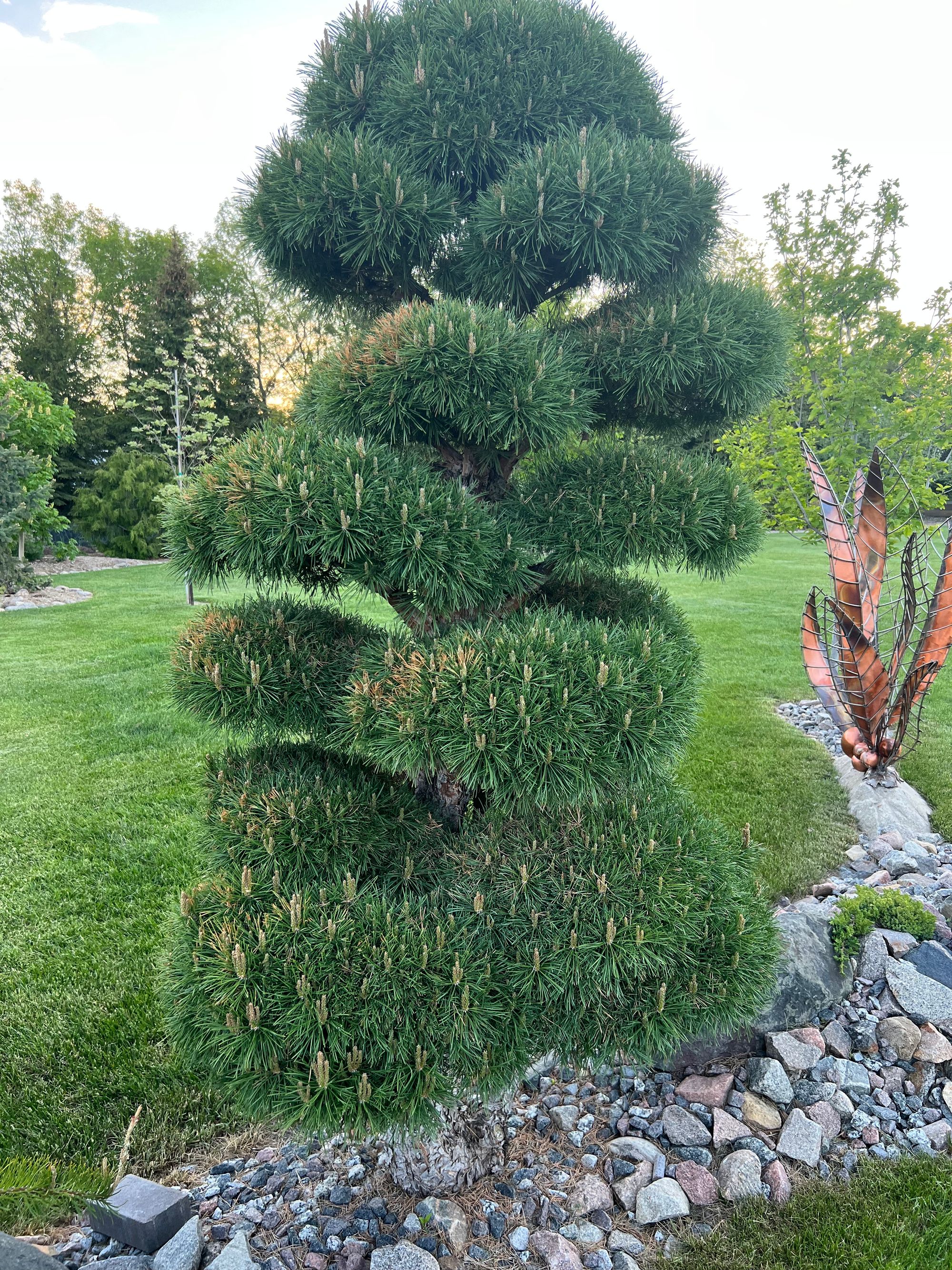
This blog post highlights 16 conifers hardy to Zones 2-4, all with unique characteristics. The video takes you on a tour of each variety. I've also included a photo gallery of the varieties covered in the video.
At the end, I've linked to a video that shows a summer-to-winter comparison of all these great conifers.
Here's the lineup:
- European Weeping Larch, Larix decidua ‘Pendula’
- Dwarf Sester Colorado Blue Spruce, Picea pungens ‘Sester Dwarf’
- Columnar Scotch Pine, Pinus sylvestris ‘Fastigiata’
- Quebec Weeping Cedar, Thuja occidentalis ‘Quebec Weeping’
- Taylor Juniper ‘Juniperus virginiana ‘Taylor’
- Taylor’s Sunburst Lodgepole Pine, Pinus contorta ‘Taylor’s Sunburst’
- Weeping Norway Spruce, Picea abies ‘Pendula’
- Weeping Colorado Blue Spruce, Picea pungens var. glauca ‘Pendula’
- Globe Blue Spruce, Picea pungens ‘Globosa’
- Sherwood Compact Bristlecone Pine, Pinus longaeva ‘Sherwood Compact’
- Dwarf Compressed Scotch Pine, Pinus sylvestris ‘Glauca Nana’
- Uncle Fogy Jack Pine, Pinus banksiana ‘Uncle Fogy’
- Blue Weeping Alaskan Cedar, Chamaecyparis nootkatensis ‘Glauca Pendula’
- Winter Sun Mugo Pine, Pinus mugo ‘Wintersonne’
- Horstman’s Recurved Larch, Larix decidua ‘Horstmann’s Recurva’
- Weeping White Spruce, Picea glauca ‘Pendula’
European Weeping Larch, Larix decidua ‘Pendula’
I’m starting to get a little needle cast on some of the inner branches of this weeping Larch. It could be due to the shade the outer branches are causing as it grows. I irrigate my lawn with well water, and I’m suspicious that the water is a little high in salt and could be adding to the problem. I also notice a similar needle cast on some of my Norway spruce trees. Always something! Larch trees are deciduous evergreens, so they are not as showy in the winter as other evergreens but make up for it with their yellow fall color.
- Size: 4-6'H x 4-6'W
- Hardiness: Zone 2
- Location: Full Sun
- Shape: Weeping
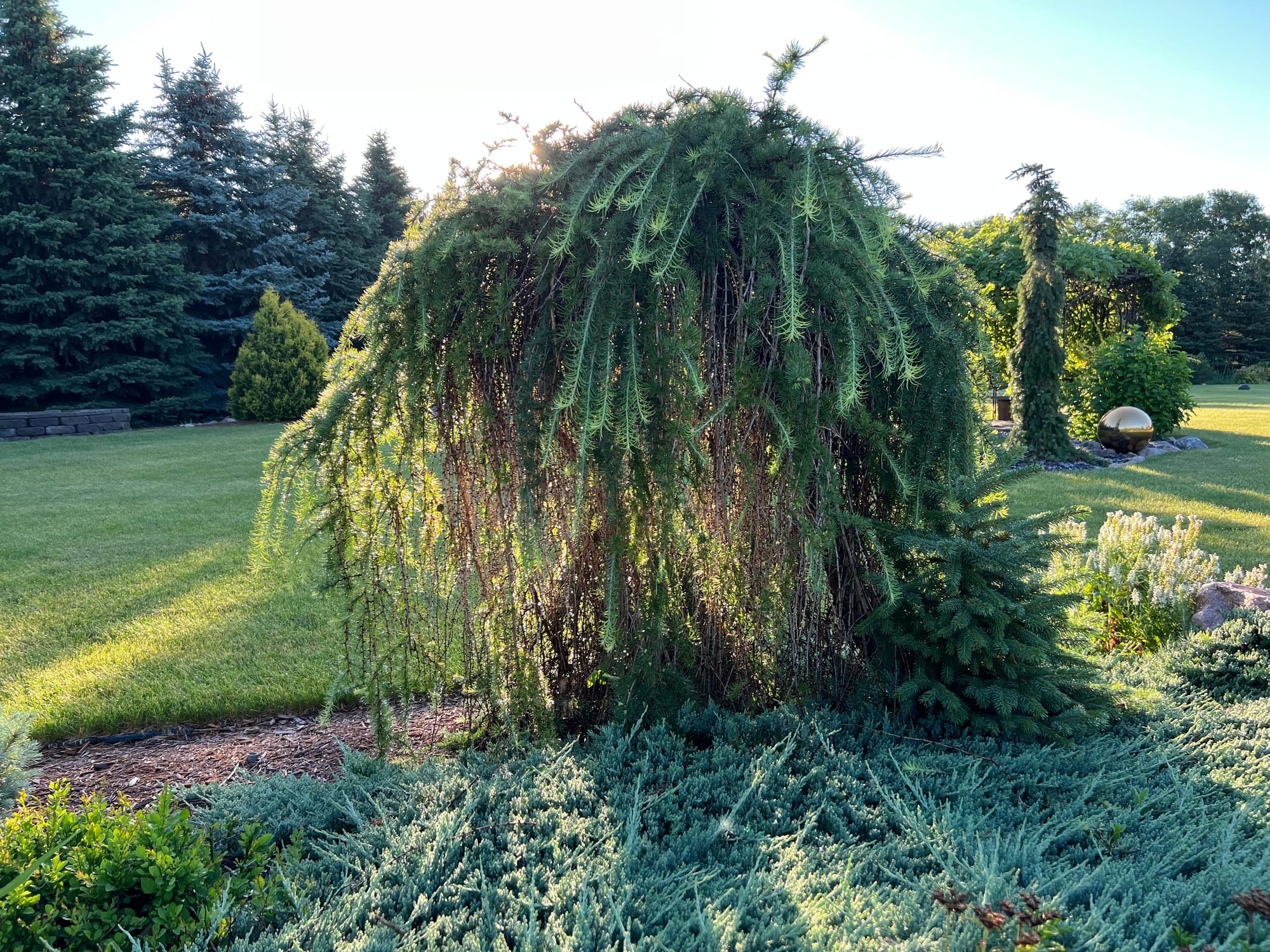
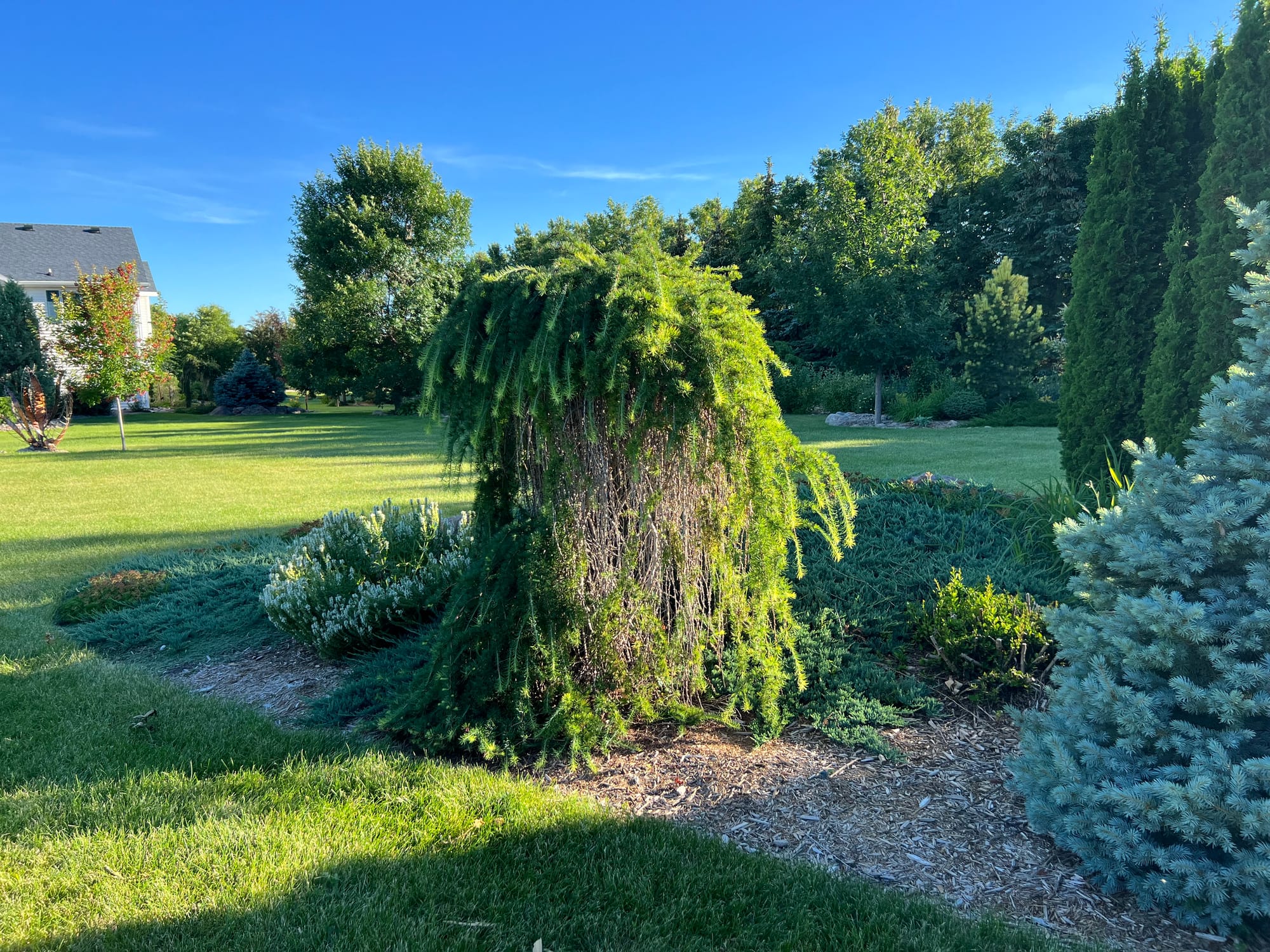
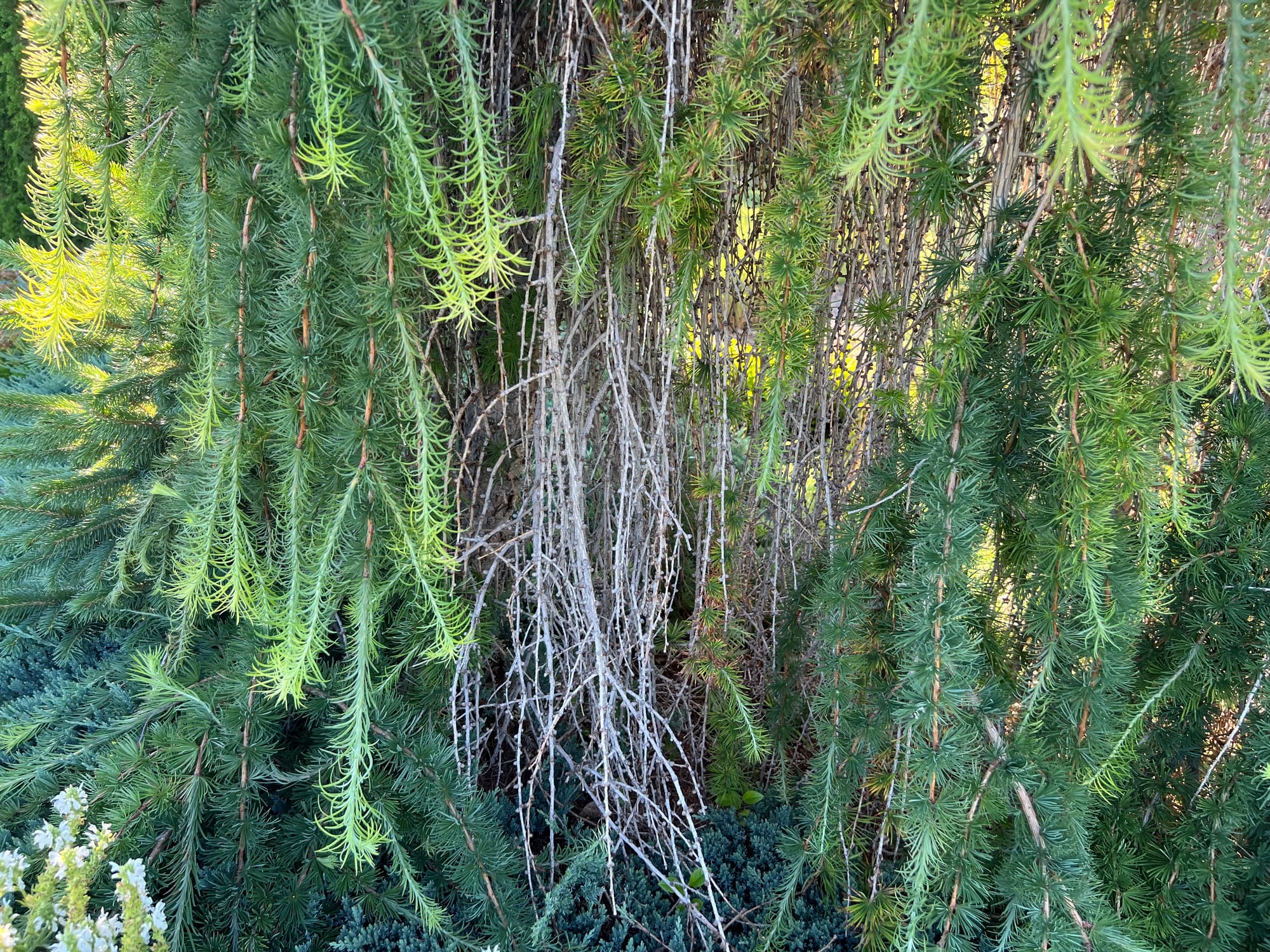
European Weeping Larch, Larix decidua ‘Pendula’
Dwarf Sester Colorado Blue Spruce, Picea pungens ‘Sester Dwarf’
Dwarf Sester is the perfect spruce for small gardens. Sester’s Dwarf is a seedling selection from Sester Farms out of Gresham, Oregon. I love the stunning blue needles in both summer and winter. It requires virtually no maintenance due to its excellent cold hardiness and slow growth rate.
- Size: 6’H x 4’W
- Hardiness: Zone 2
- Location: Full Sun
- Shape: Broad Upright
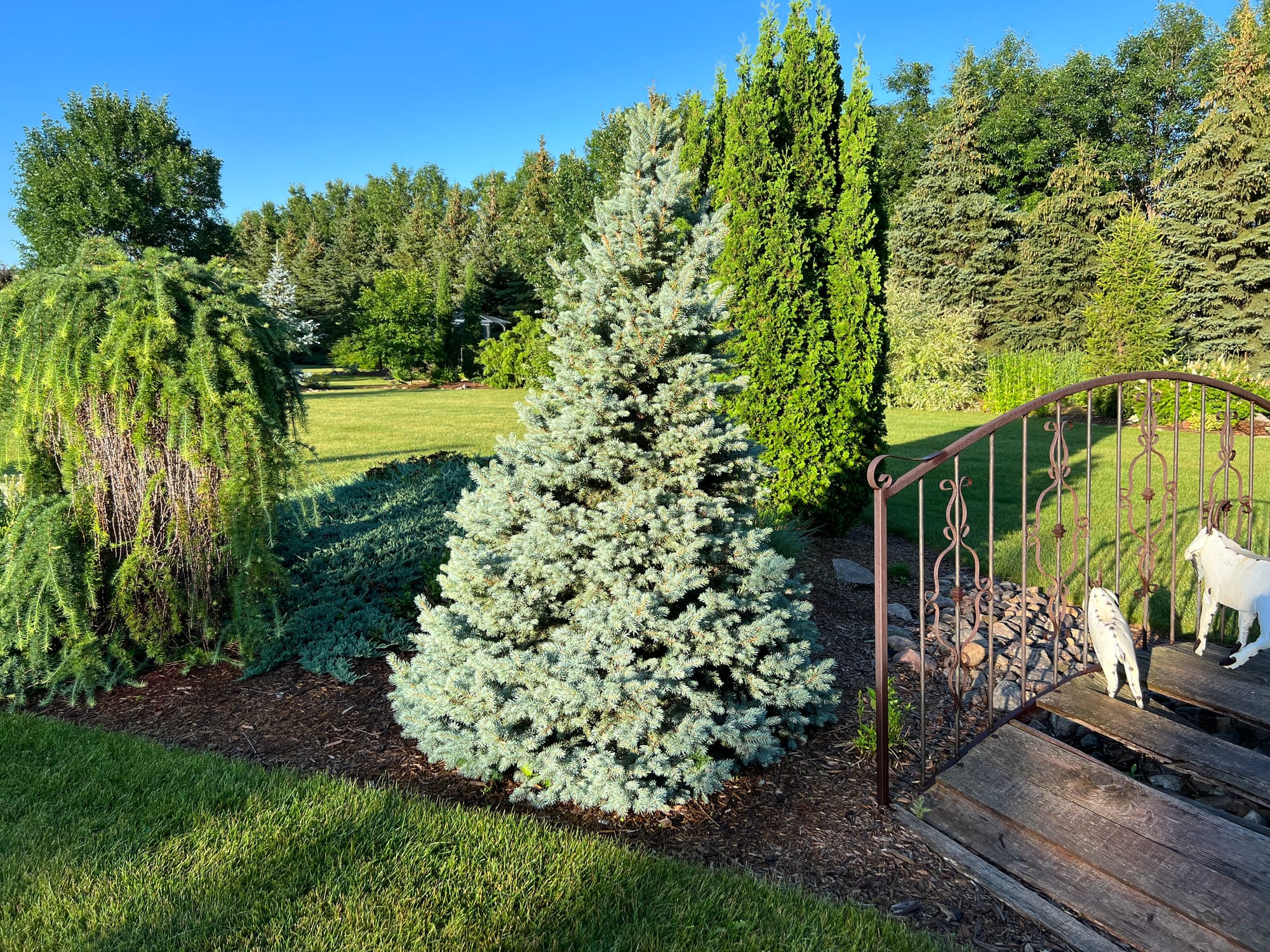
Dwarf Sester Colorado Blue Spruce, Picea pungens ‘Sester Dwarf’
Columnar Scotch Pine, Pinus sylvestris ‘Fastigiata’
The Pyramidal Scotch you see here did not make it through the most recent winter since the video was posted. Scotch Pines are normally hardy in my area of the northern Great Plains (Zone 4). We don’t always have an answer to why plants die, which is the case here. This pyramidal Pine was planted in a dry year, and even though I hand-watered the tree, nothing beats natural rain for the establishment and plant health. If I come across another one, I will plant this variety again, as I especially liked the needle color on this columnar Scotch.
- Size: 20-25’H x 6-8’W
- Hardiness: Zone 3-7
- Location: Full sun
- Shape: Columnar
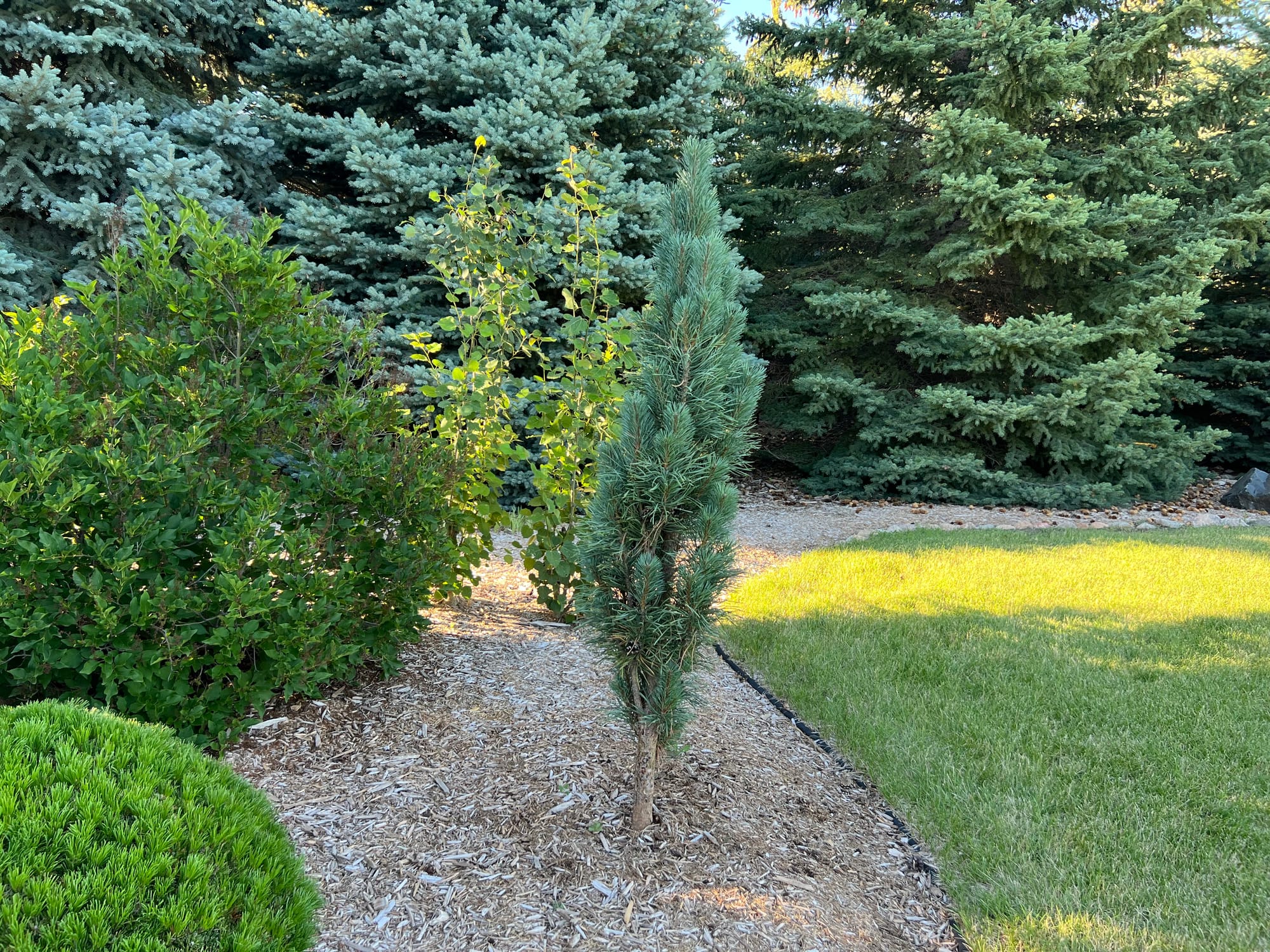
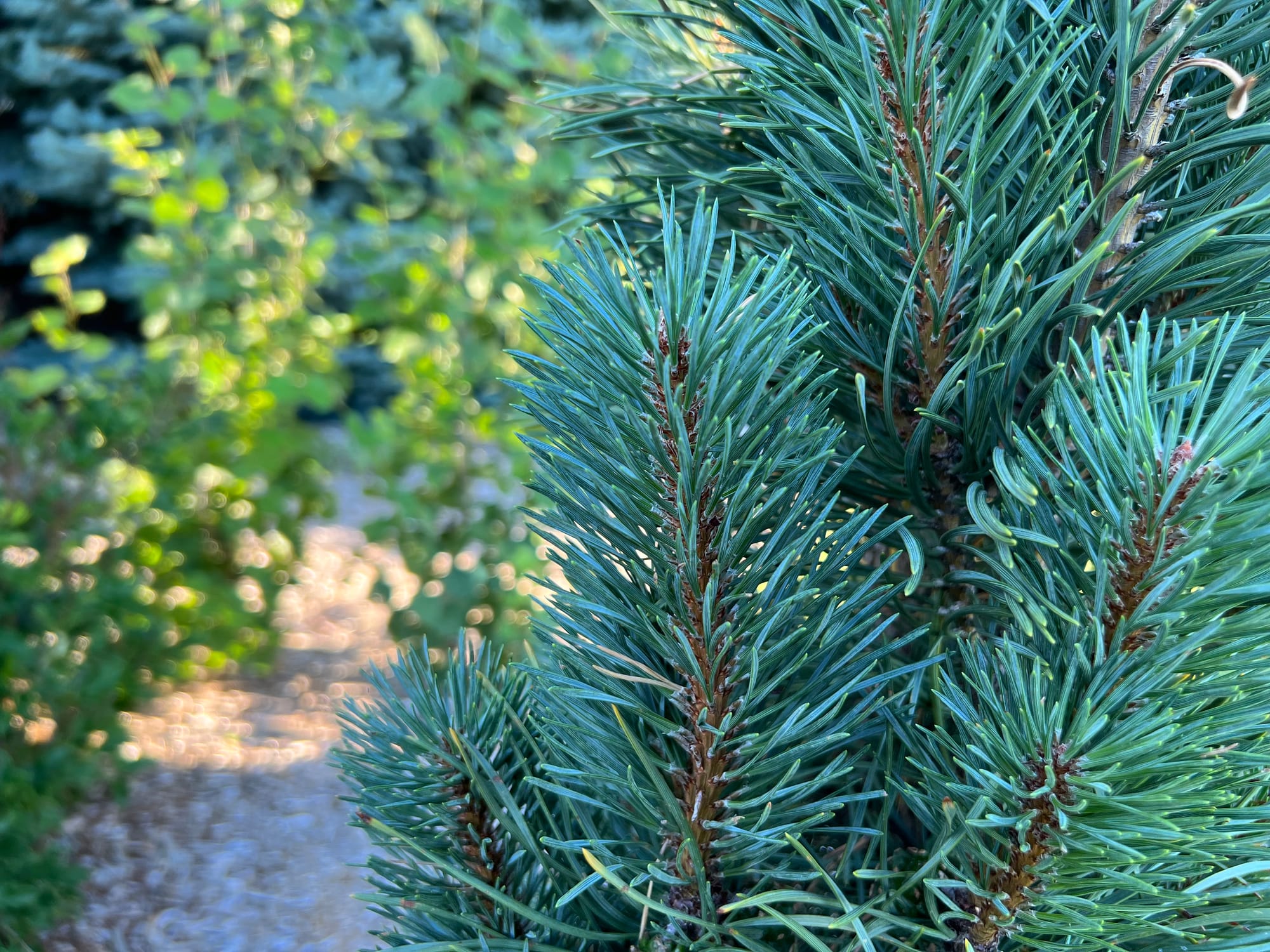
Columnar Scotch Pine, Pinus sylvestris ‘Fastigiata’
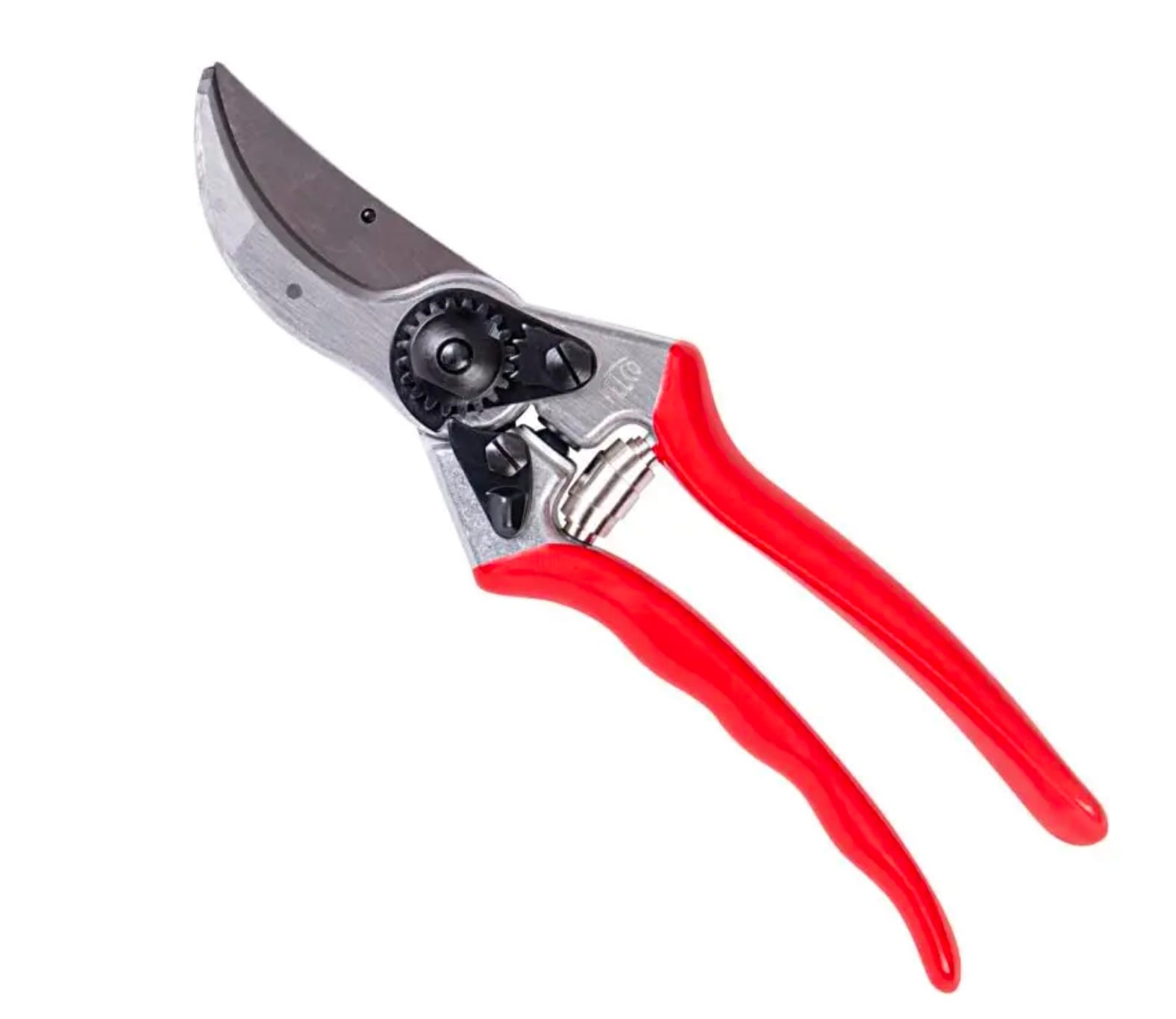
FELCO Model 2 Hand Pruner
FELCO's Classic award winning pruner. Long lasting durability.
When you purchase through links on this site, we may earn a small commission at no additional charge to you.
Quebec Weeping Cedar, Thuja occidentalis ‘Quebec Weeping’
I love this tree! I can’t give you one specific reason, but it just “fits” the location. I love the shape, coloring, and habit. I did not remember the name for many years after planting. Then, one day, I invited the rep from Iseli Nursery to my landscape to share how some of the plants he had sold me over the years were performing. Luckily, he identified it for me. Since it has a weeping habit, I’m unsure how much taller it will get. It looks like it can range between 15 and 25 feet. I’ve meant to find a long pole each season and train the main leader higher. But I always fall back on just letting it be.
- Size: 15-25’H x 10-15’W
- Hardiness: Zone 3-7
- Location: Full Sun to Part Shade
- Shape: Weeping
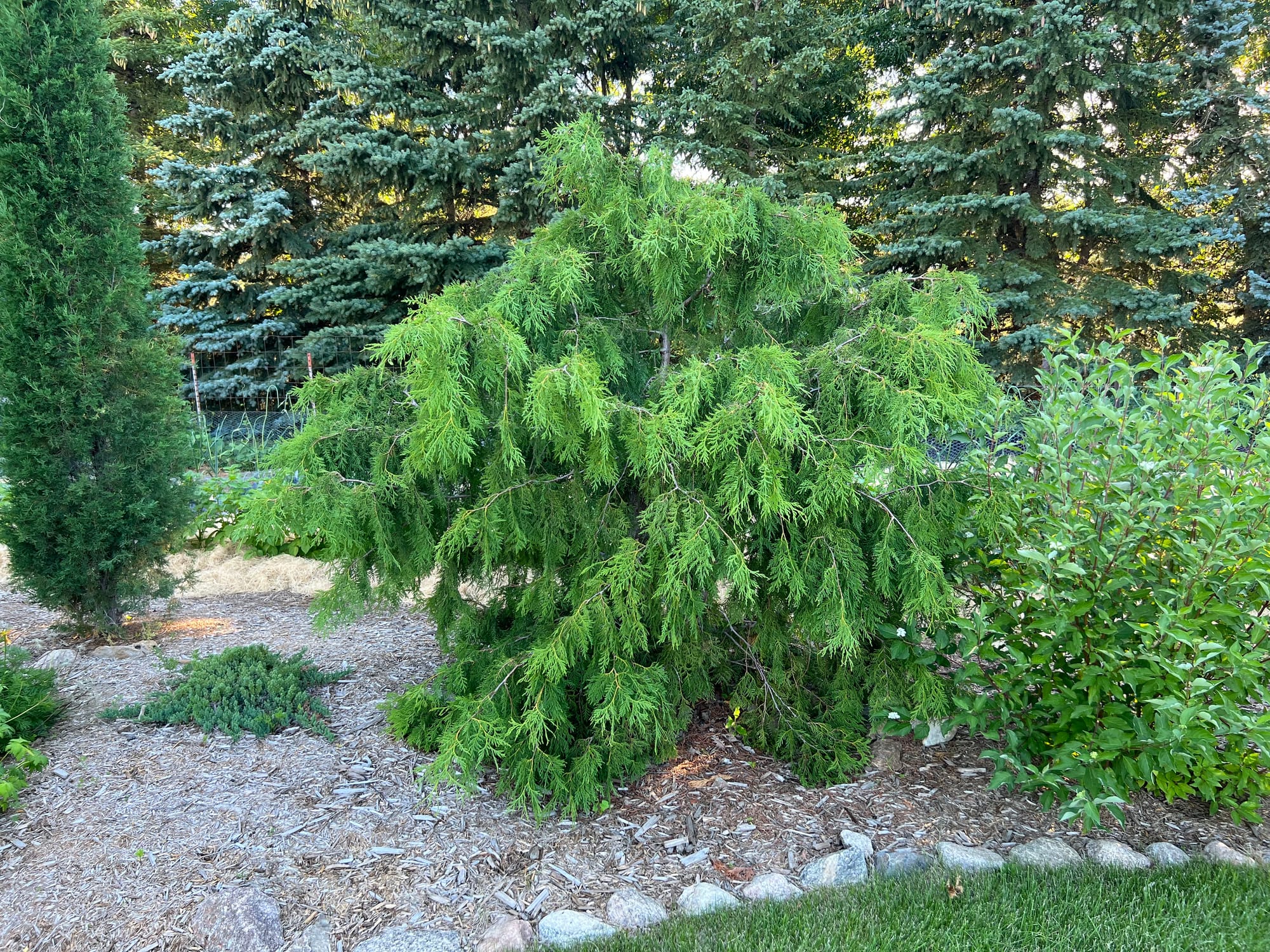
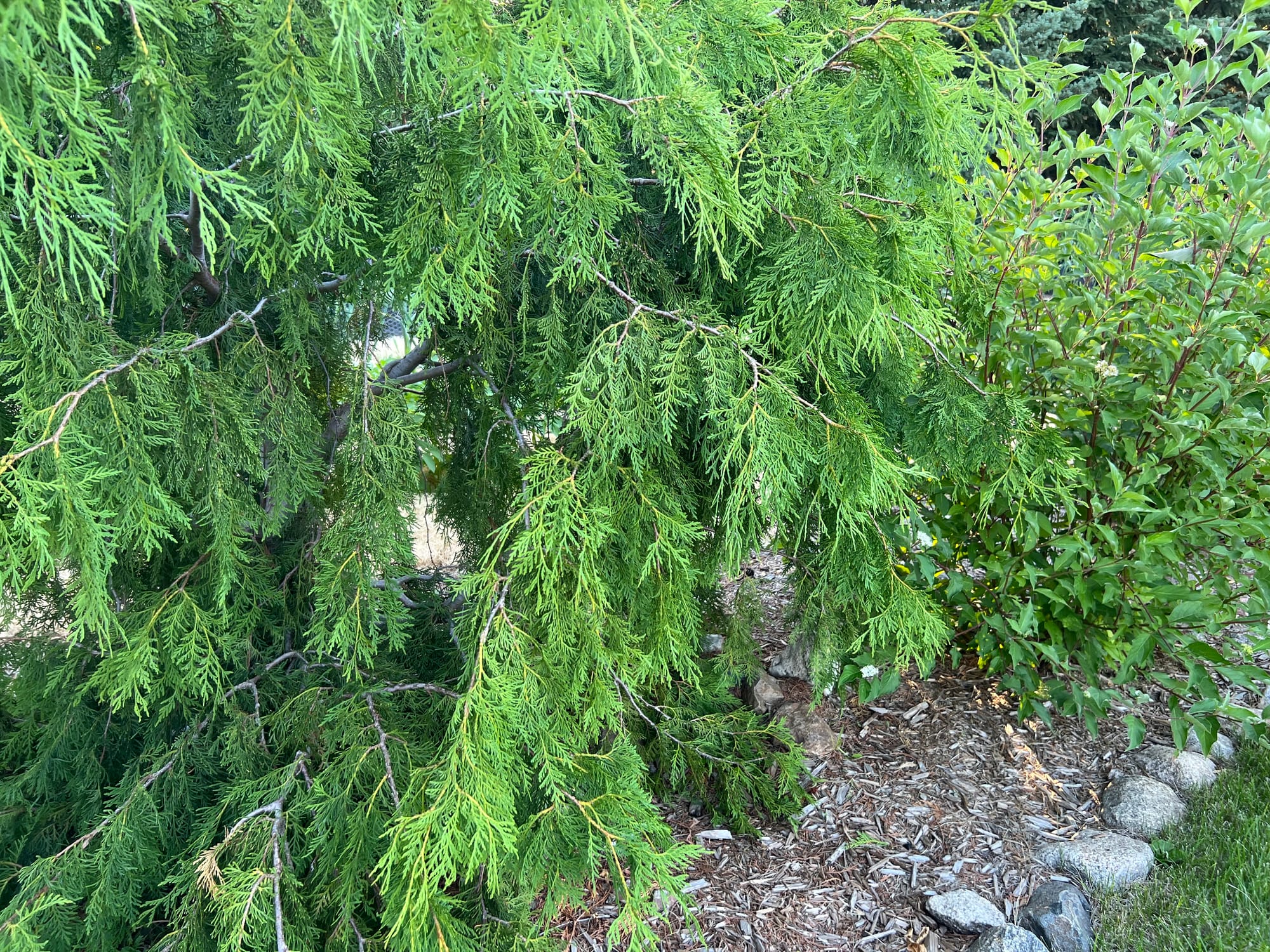
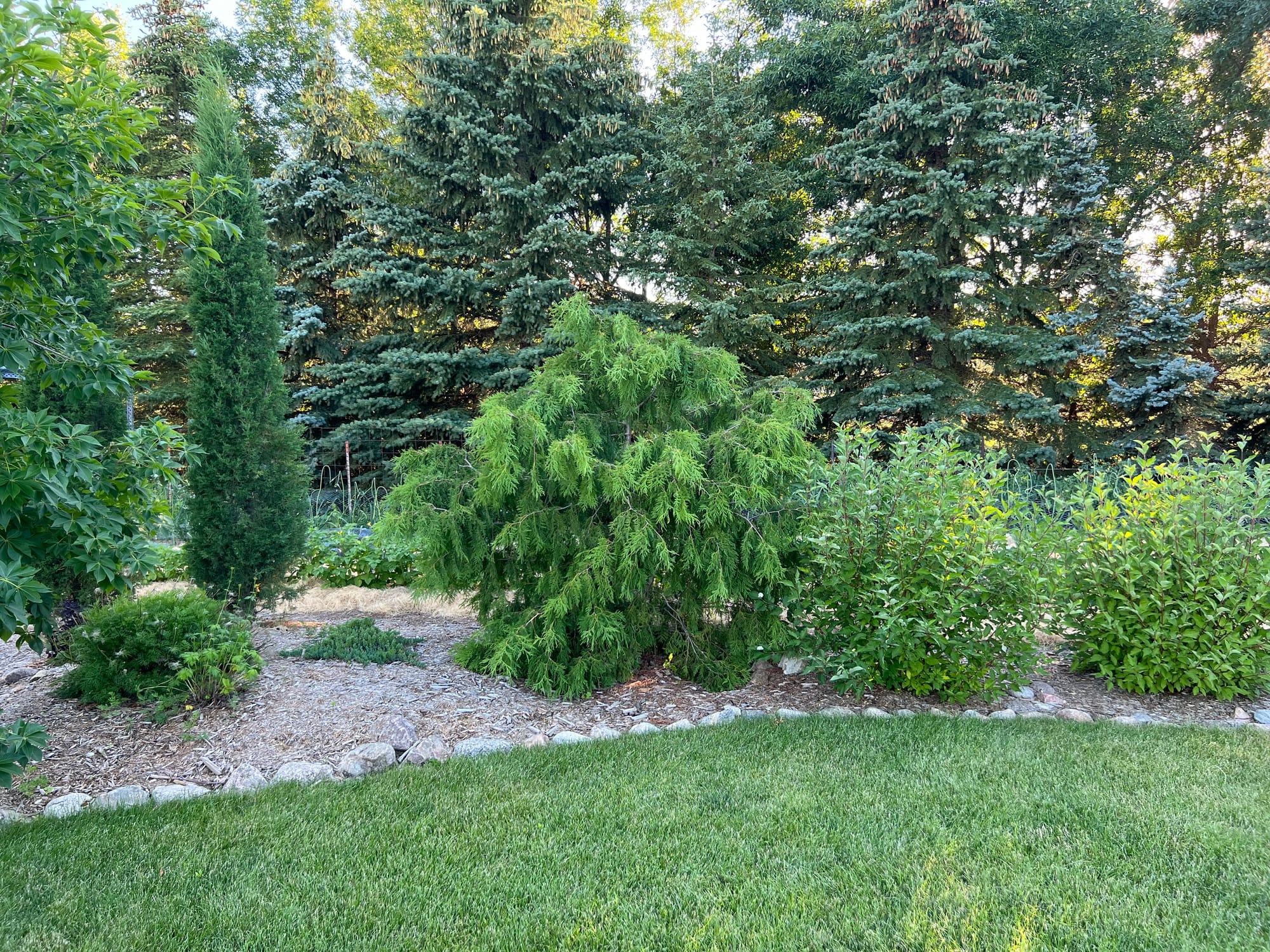
Quebec Weeping Cedar, Thuja occidentalis ‘Quebec Weeping’
Taylor Juniper, Juniperus virginiana ‘Taylor’
On my Gardens Hike YouTube channel, one commenter poked fun at me for saying the Taylors had an “eye” talion look rather than an “it” talion look. I don’t make that mistake anymore. Or at least now I can edit out the pronunciation mistake if necessary.😊 The Taylors are likely the most narrow Juniper you can grow in my area. I love tall, narrow, pyramidal plants planted out in the open! I also enjoy the bronzy winter color on this Juniper. Notice the sharp contrast in the photos below. I hope to see them reach their maximum height of around 30 feet in my lifetime. They’re halfway there! If not, I’m confident the next caretaker we’ll love them too.
- Size: 30’H x 3’W
- Hardiness: Zone 4-9
- Location: Full Sun
- Shape: Columnar
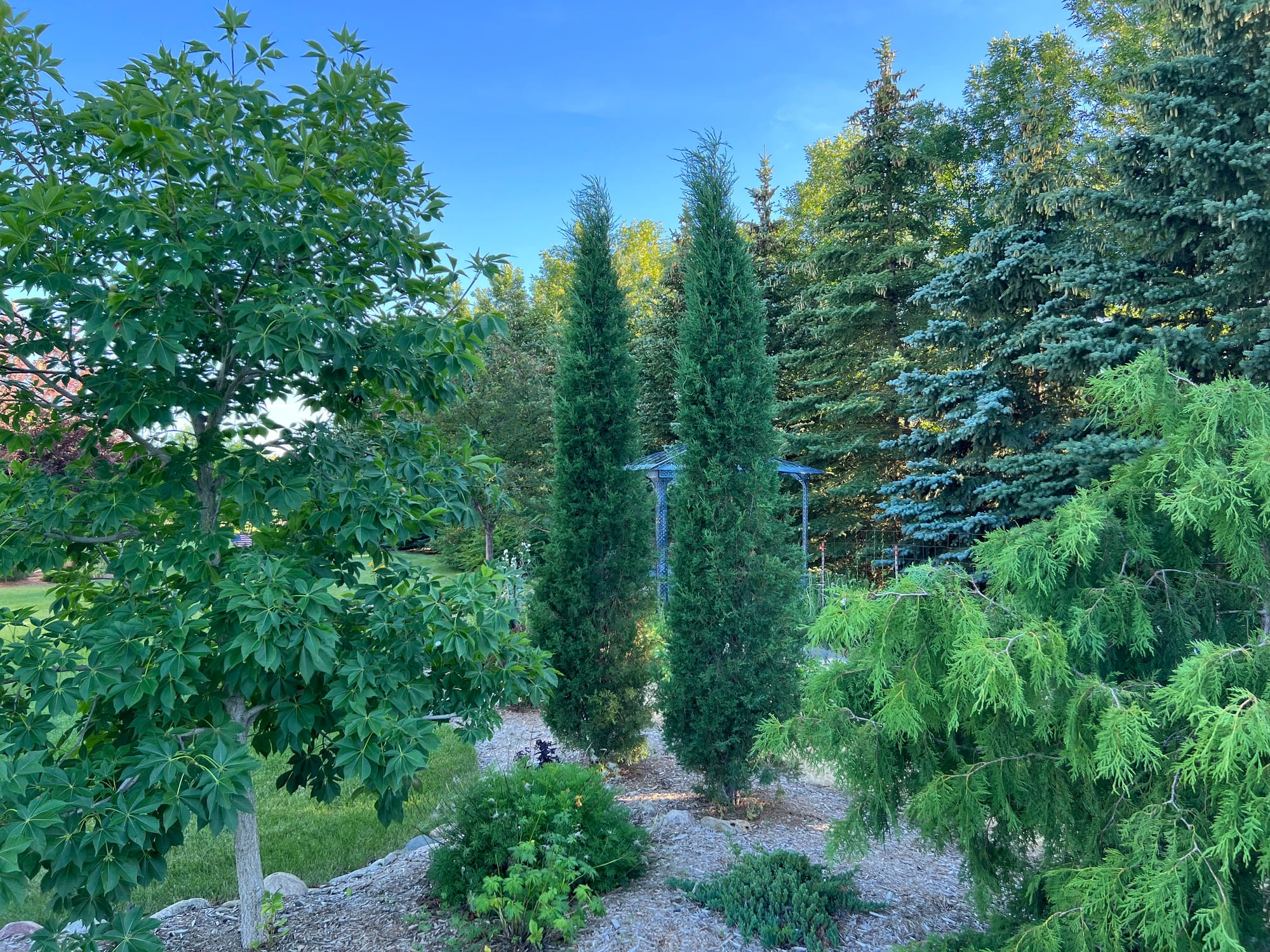
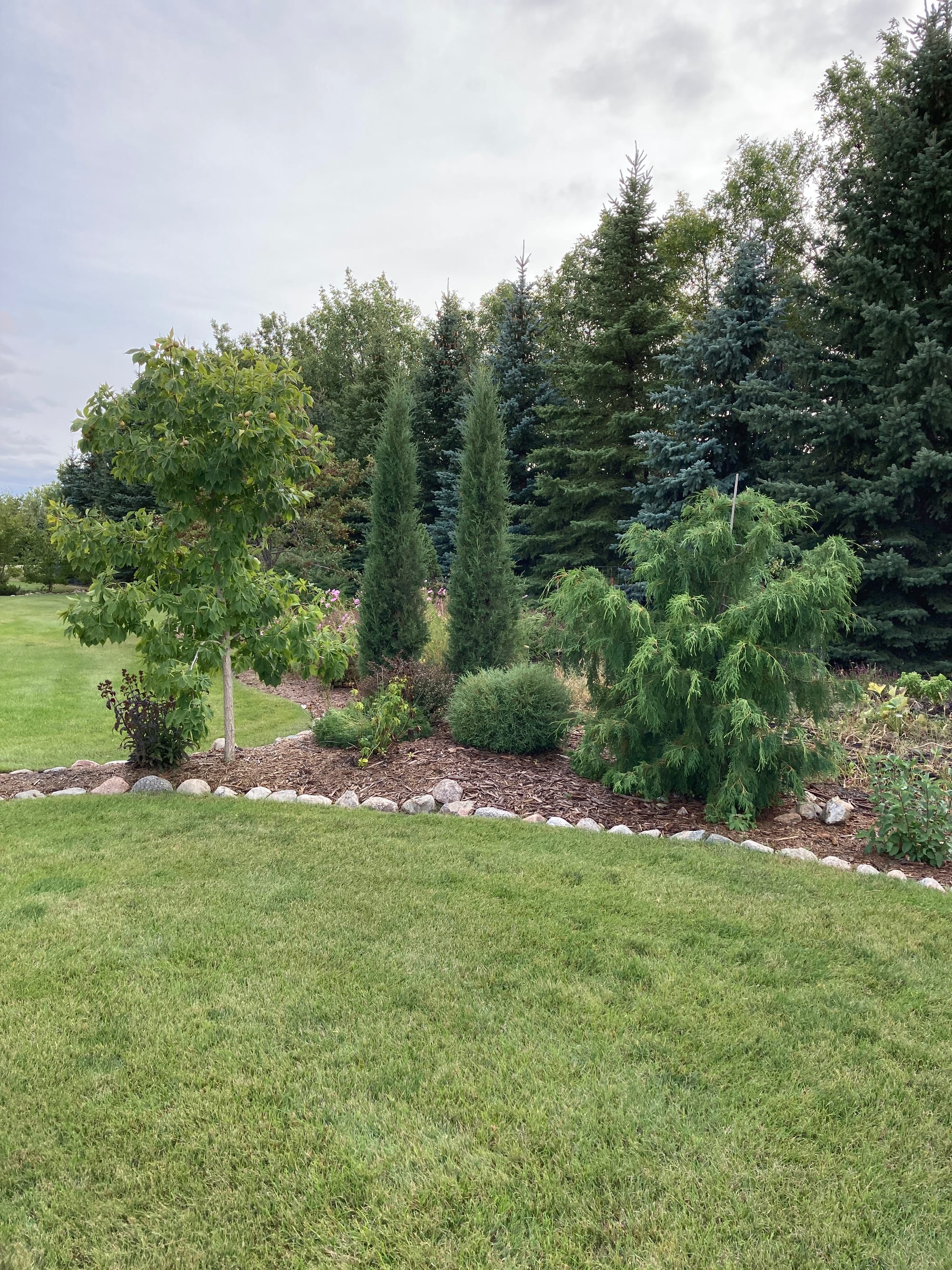
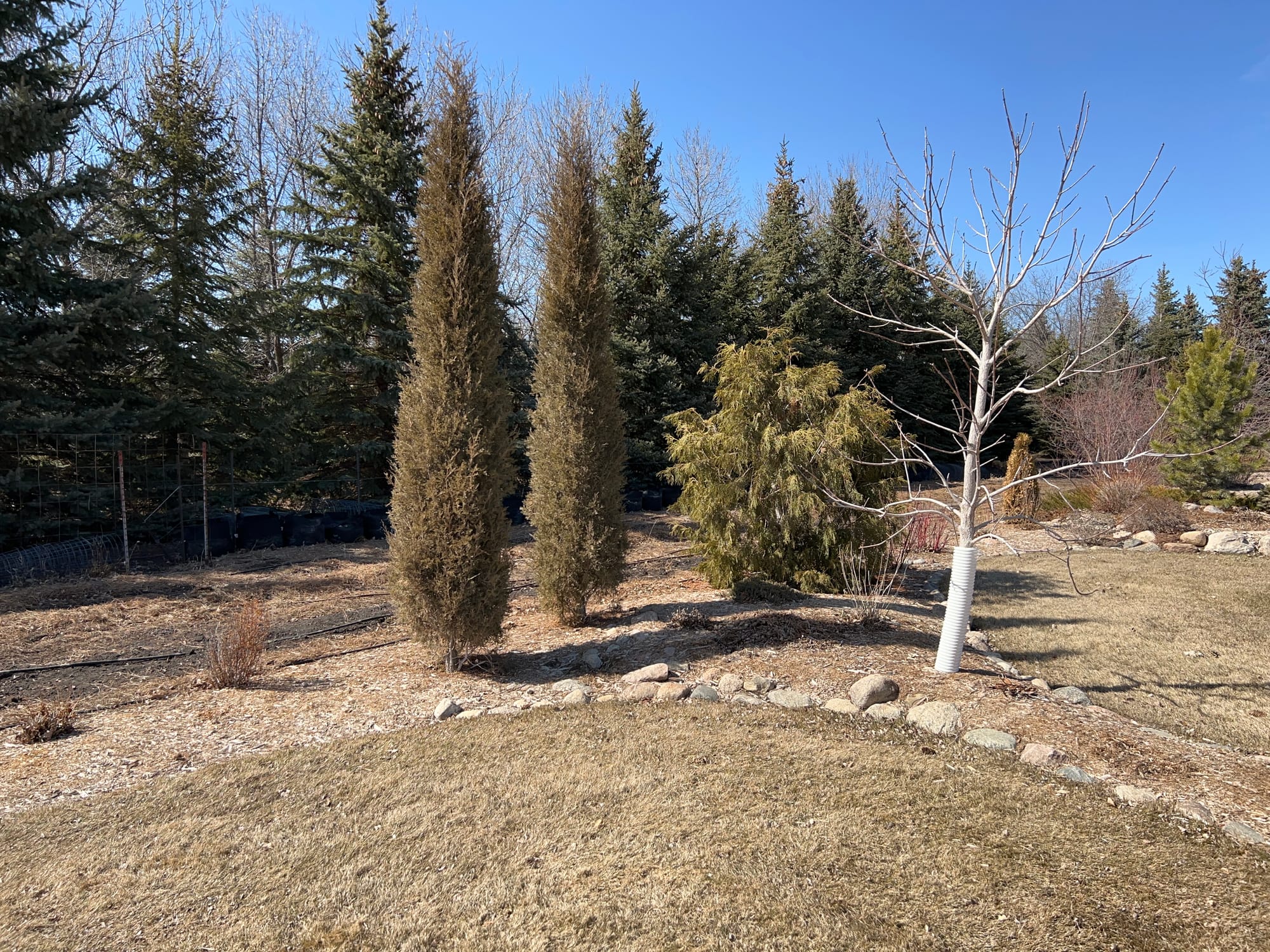
Taylor Juniper, Juniperus virginiana ‘Taylor’
Taylor’s Sunburst Lodgepole Pine, Pinus contorta ‘Taylor’s Sunburst’
The brilliant new yellow growth is hard to beat on this Pine. It’s a show-stopper! The yellow needles will last for 3-4 weeks before turning a darker and darker green as the season progresses. Tiny red cones add a pop of color for contrast. Towards the end of this post, we’ll discuss Winter Sun Mugo Pine, which does the opposite; yellow needles show up in the fall and last through the winter.
- Size: 12’H x 8’W
- Hardiness: Zone 4
- Location: Full Sun
- Shape: Broad Upright
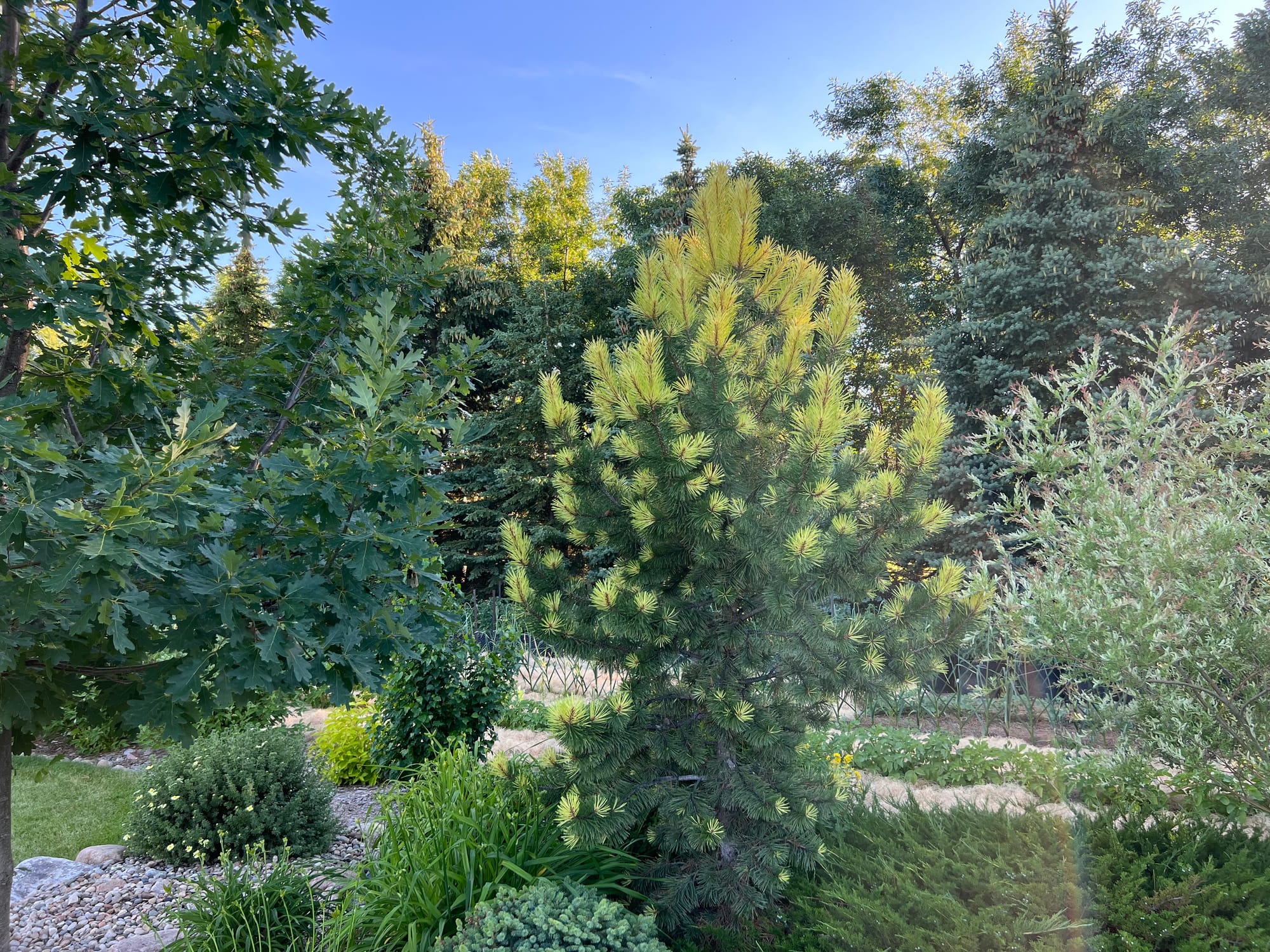
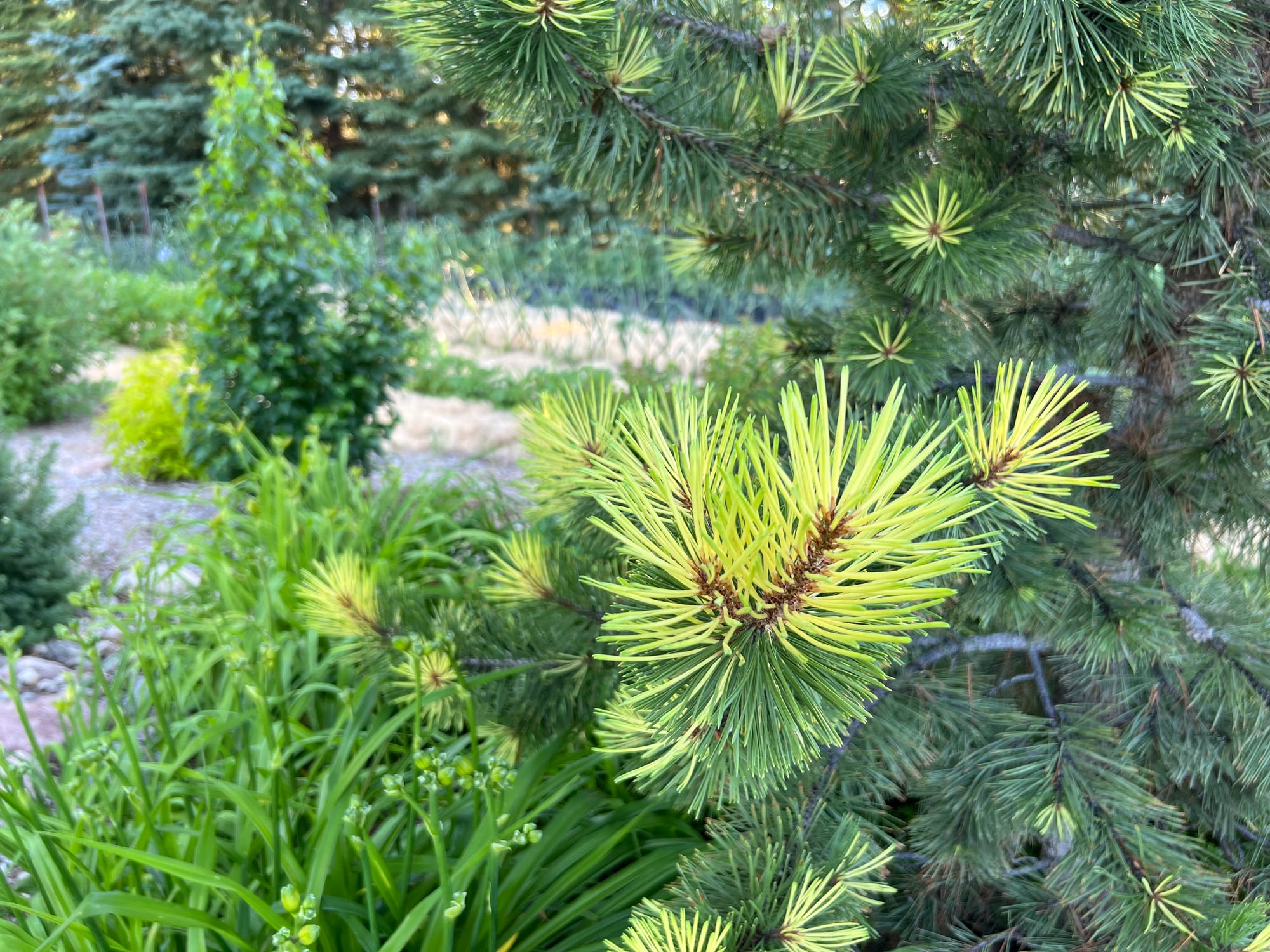
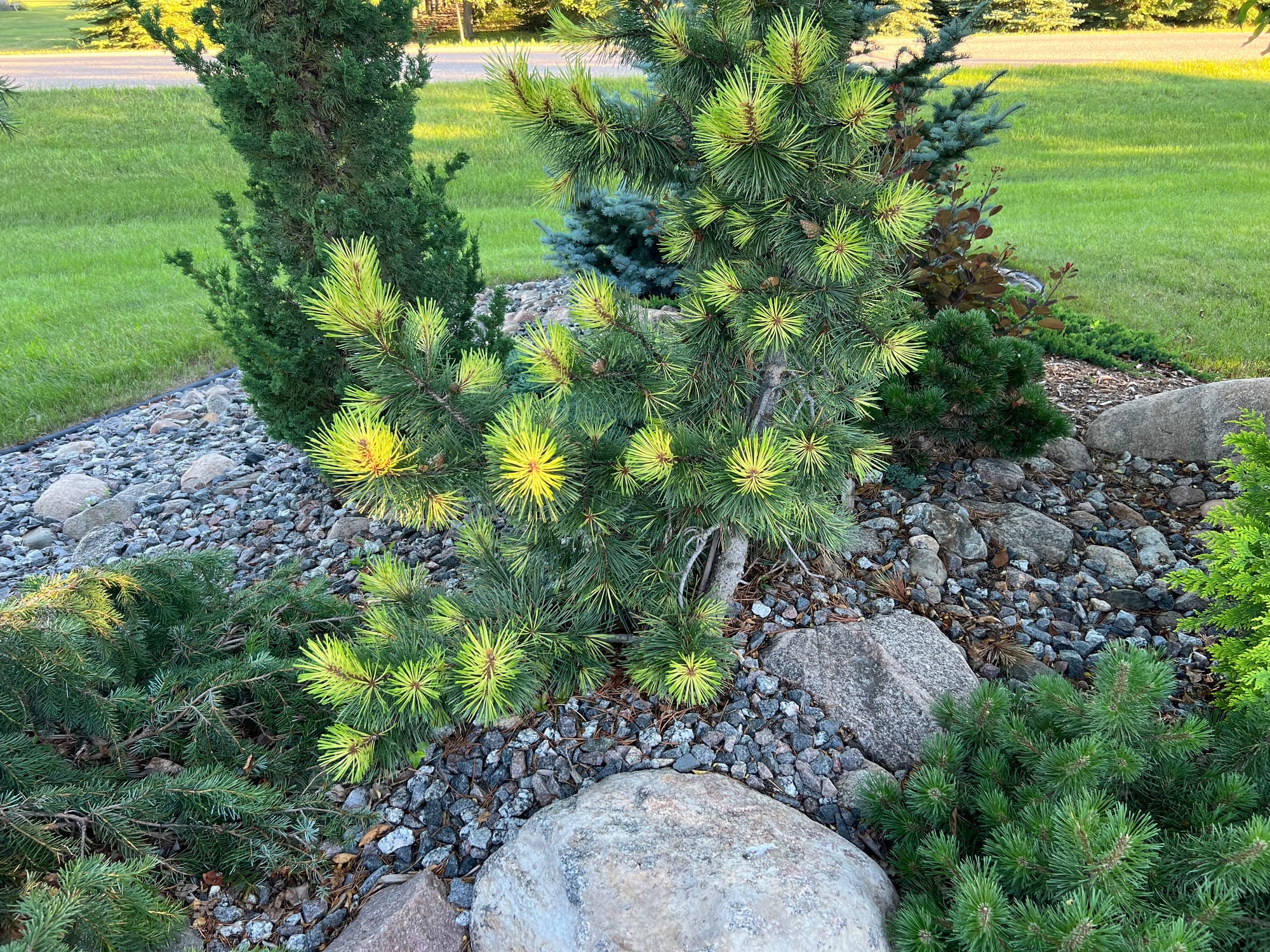
Taylor’s Sunburst Lodgepole Pine, Pinus contorta ‘Taylor’s Sunburst’
Weeping Norway Spruce, Picea abies ‘Pendula’
I have planted three Weeping Norway Spruces in this landscape over the last ten years but have lost two. The Norway Spruce group is generally considered hardy and tolerant of many different soils. The Weeping Norway shown here continues to have thin needles on many branches. As mentioned above, when discussing the Larch needle cast, I fear the well water I use is part of the problem. I’ve included a photo of another Weeping Norway planted in a different location that receives only rain for its water, and the difference is dramatic. They are so thick and lush in the second photo!
I'll note here that the Norway spruce genera are commonly used as a rootstock in the grafting part of the production process of many other conifer species due to their adaptability to various soils.
- Size: 8-12’H x 8-12’W
- Hardiness: Zone 2-8
- Location: Full Sun
- Shape: Weeping
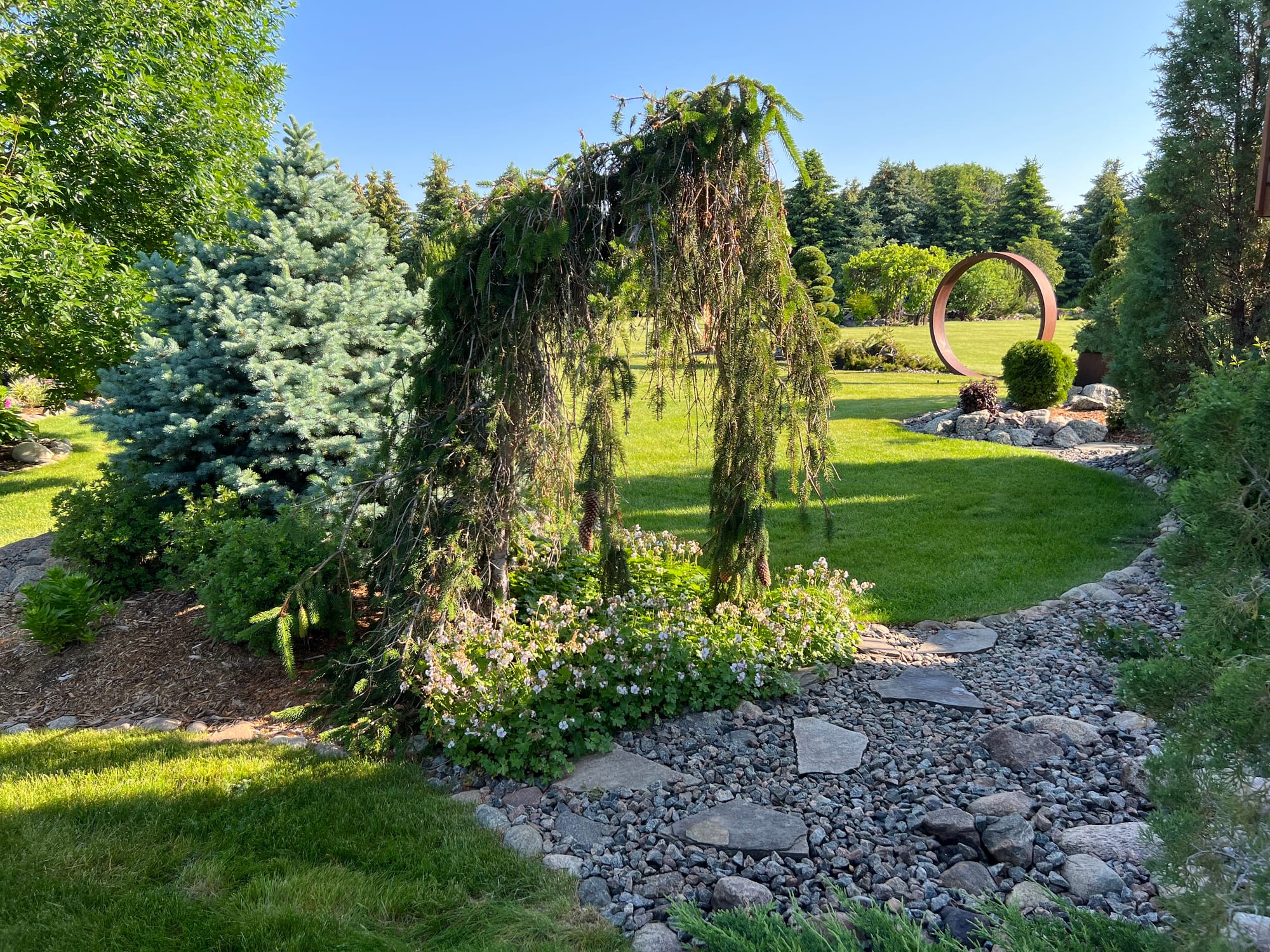
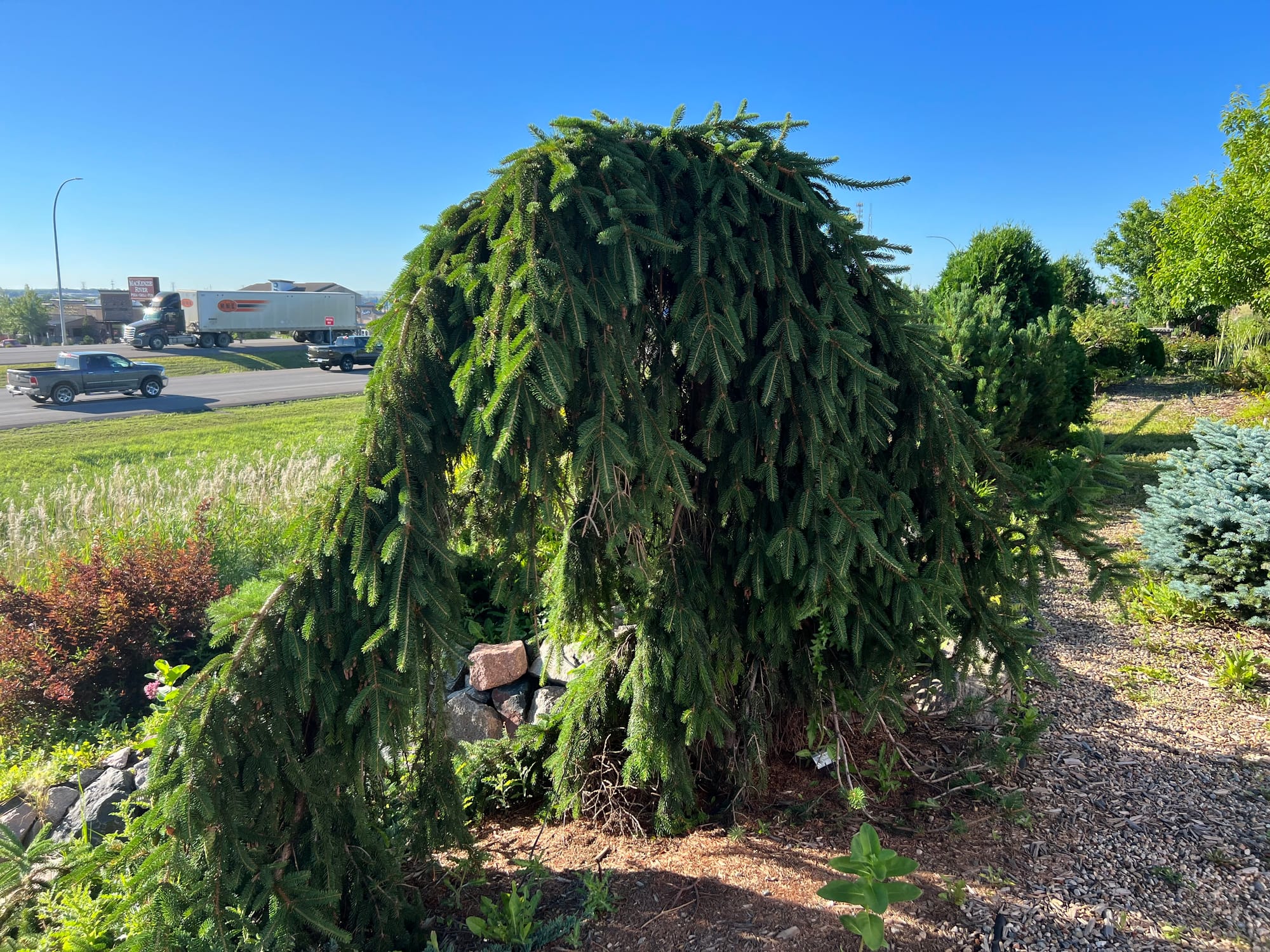
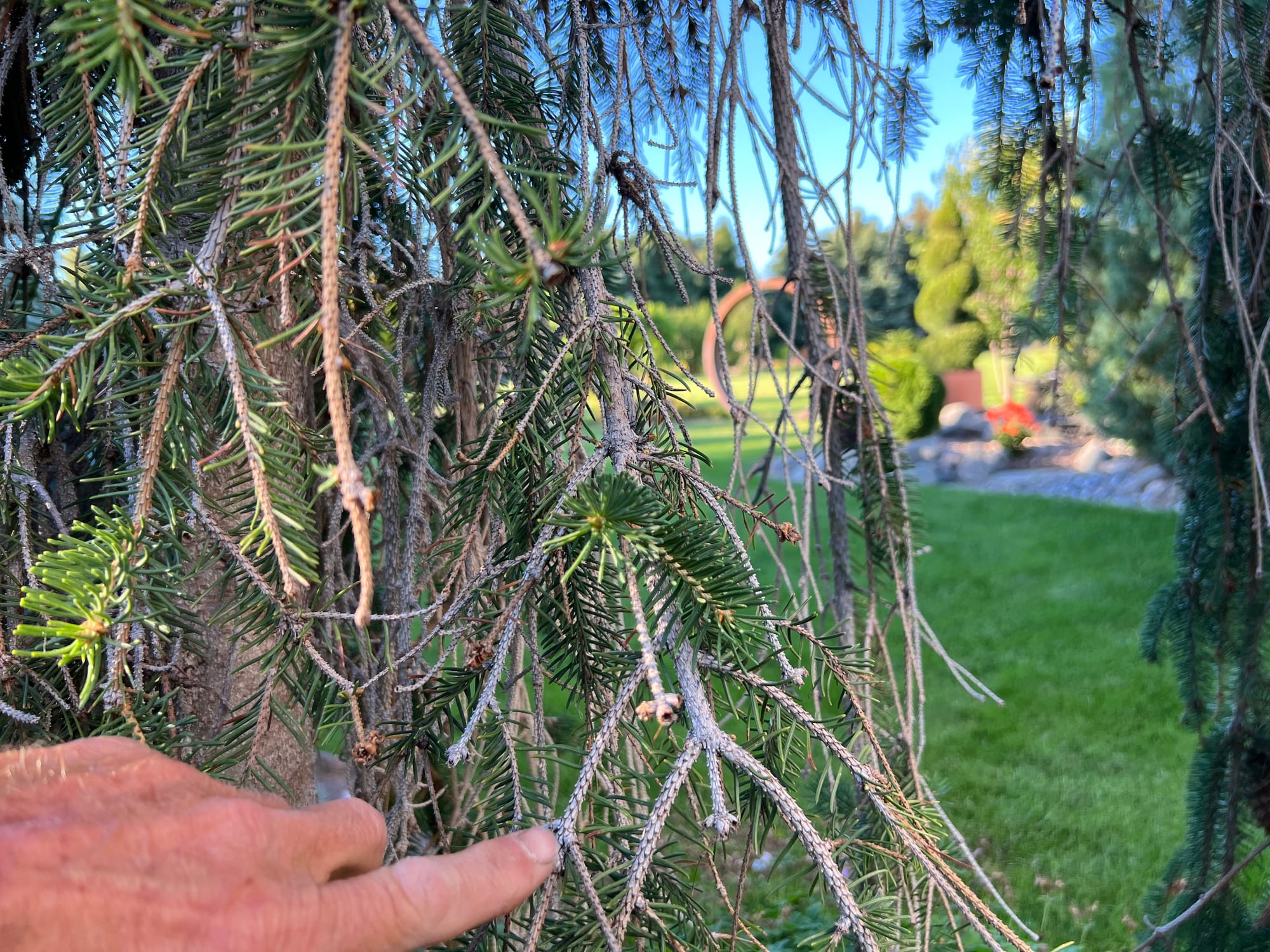
Weeping Norway Spruce, Picea abies ‘Pendula’
Make sure you check out A.M. Leonard for all your horticulture tools and supplies. They're my go-to supplier! They've been in business since 1885 and have excellent quality and selection.
Use promo code GARDENHIKE10 at checkout to receive 10% off any order.

When you purchase through links on this site, we may earn a small commission at no additional charge to you.
Weeping Colorado Blue Spruce, Picea pungens var. glauca ‘Pendula’
How great is this Colorado Spruce? Once the stake that supports the main leader is removed, unique forms will develop on this variety. I’ve included a couple of different photos. The arm in the picture is now over 7 feet long. So cool. The Colorado Spruce group continues to do very well in my more arid region of the Great Plains but can be susceptible to multiple fungal diseases in more humid areas. Like many of the blue spruce trees, the color is excellent on this variety, too. The size can vary widely depending on how it is trained.
- Size: 2-6’H x 4-12’W
- Hardiness: Zone 3-7
- Location: Full Sun
- Shape: Pendulous, Spreading, Weeping

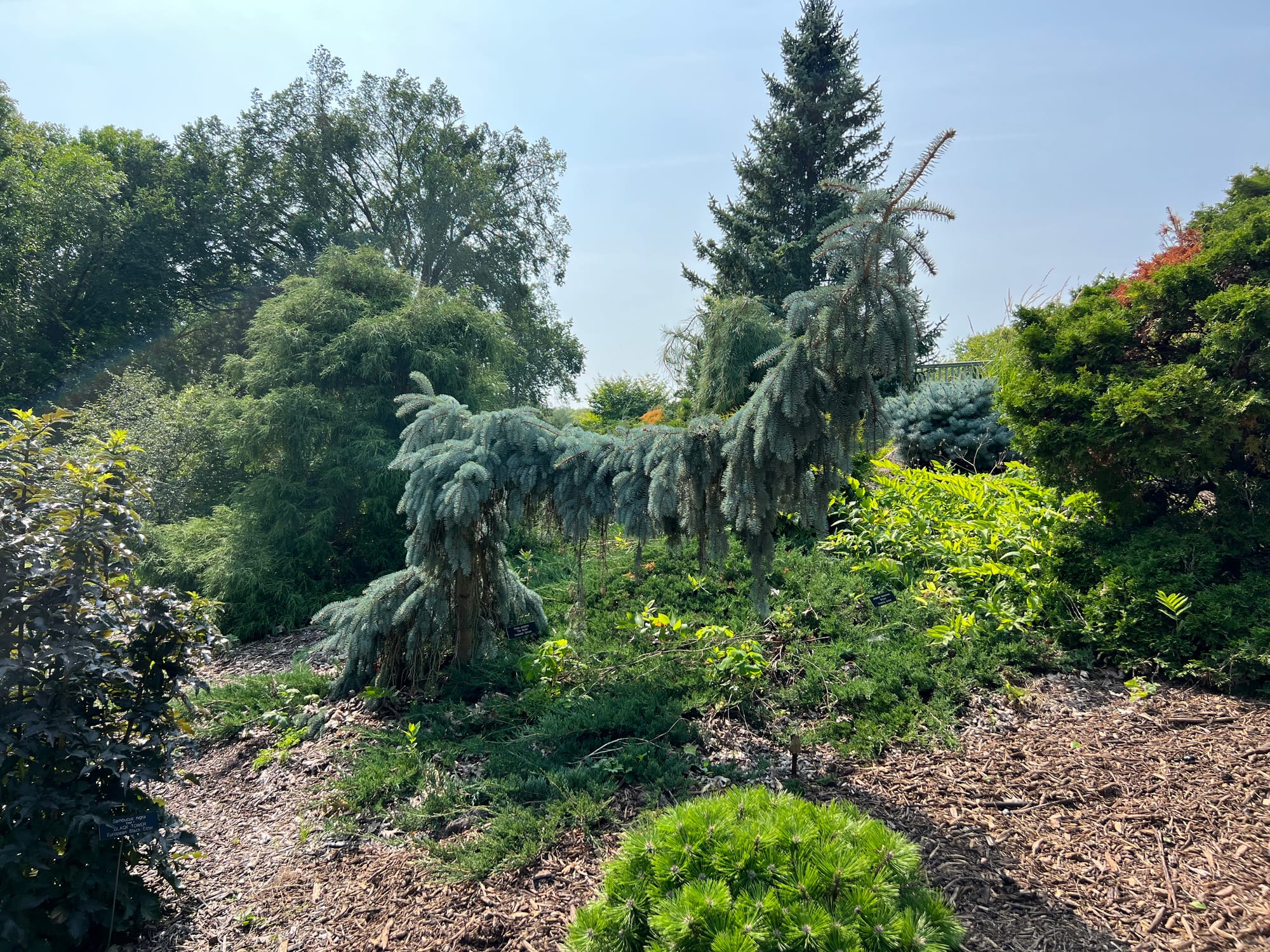
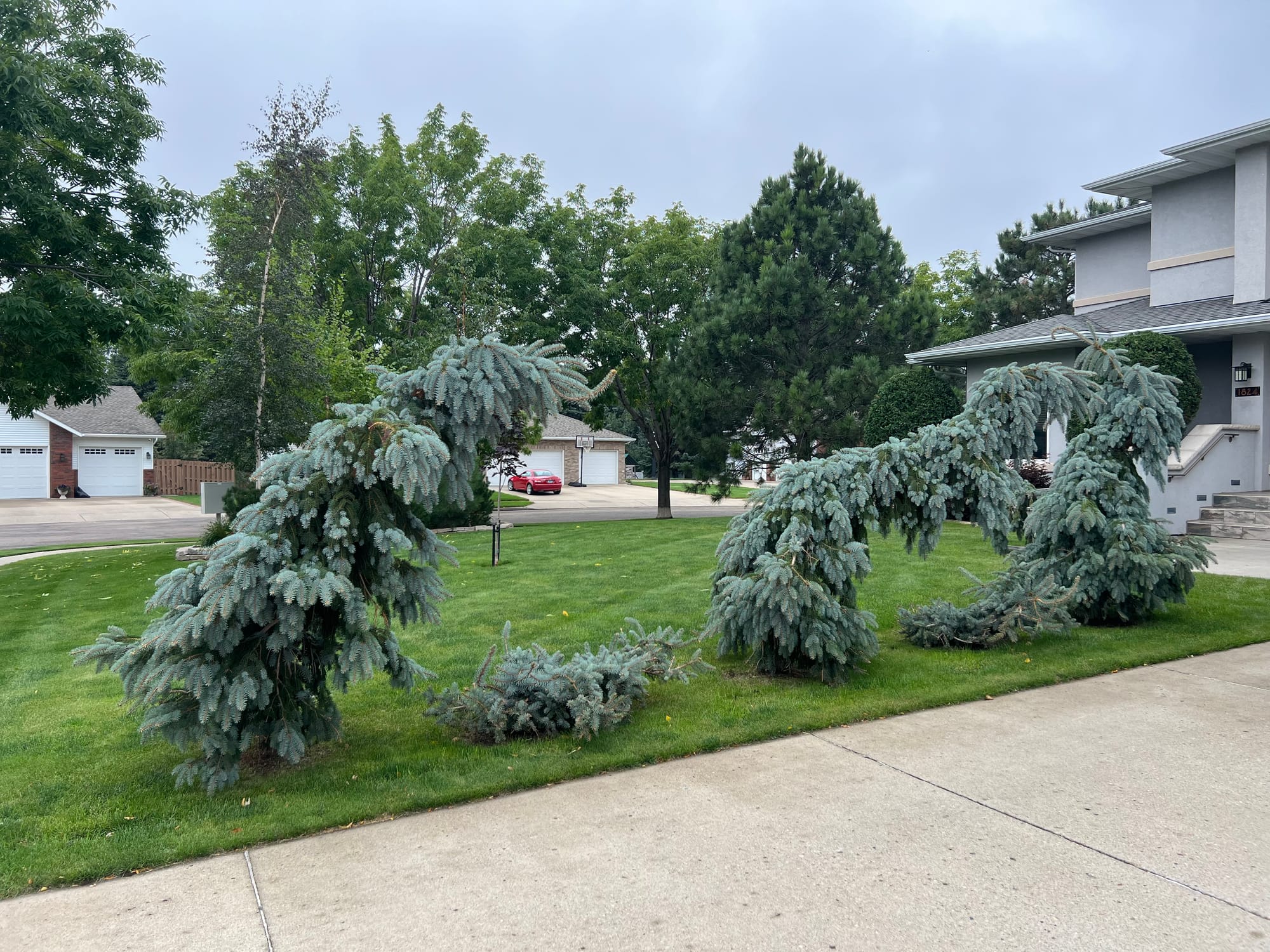
Weeping Colorado Blue Spruce, Picea pungens var. glauca ‘Pendula’
Globe Blue Spruce, Picea pungens ‘Globosa’
This variety of globe blue spruce can revert to a pyramidal form with age. I’ve shown photos below showing the leader “making a run for it.” And the picture after being pruned off. The globe shown here is getting relatively wide in the width department. I’m sure it is over 10’ wide now. You can certainly keep this variety sheared to maintain a smaller form. Many other globe Colorado spruce varieties are available that will stay small without shearing, so that may be a better option. Check out my video on "the seven dwarfs" for some options. Since they grow slower, though, they will also be more expensive in the nursery trade (time is money). It’s common to find globe spruce grafted on a standard, an excellent option for a small tree. The size listed below is what is usually listed, but now you’ve been warned about the width.
- Size: 6’H x 6’W
- Hardiness: Zone 3
- Location: Full Sun
- Shape: Globe to Vertical
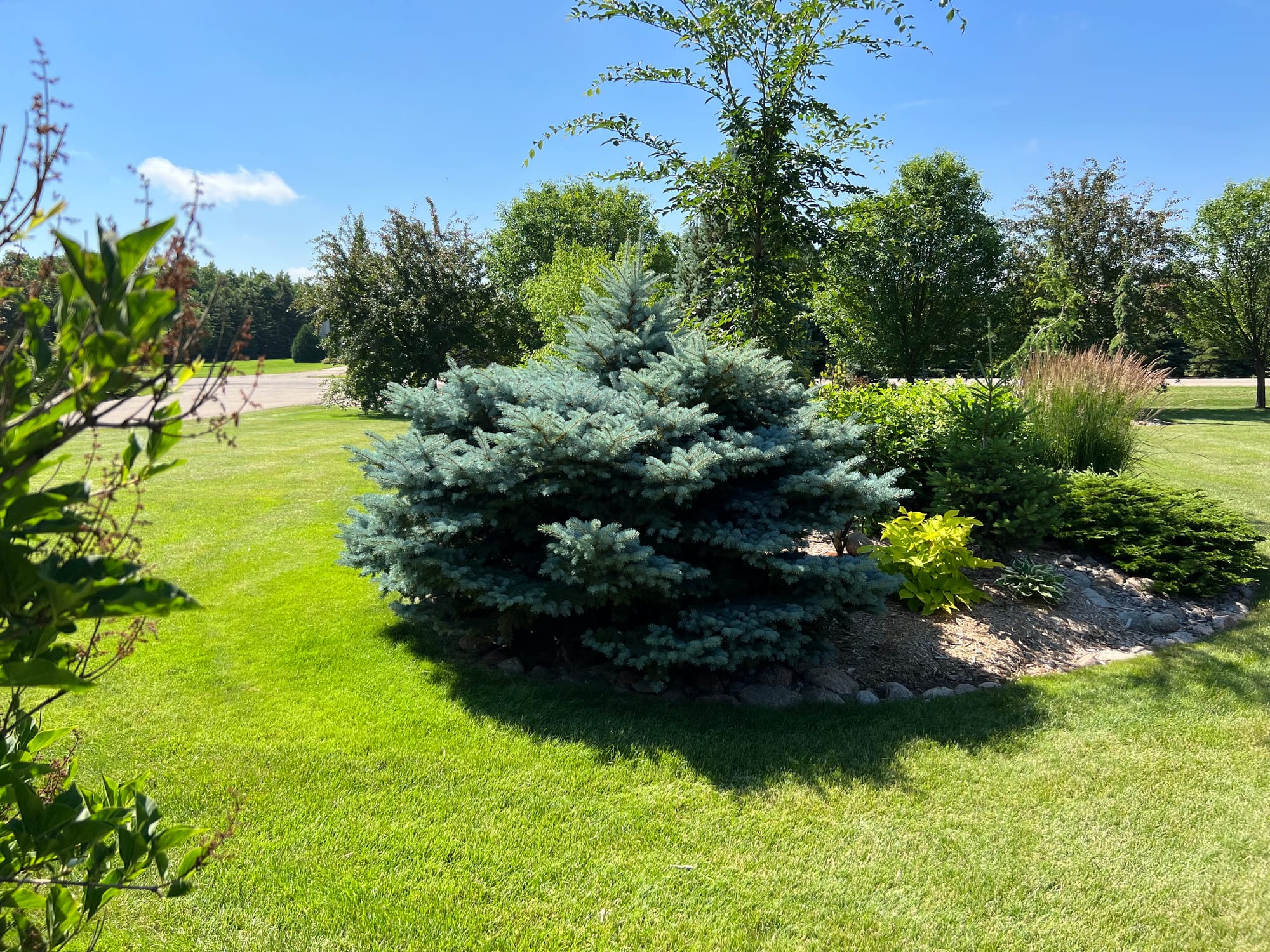
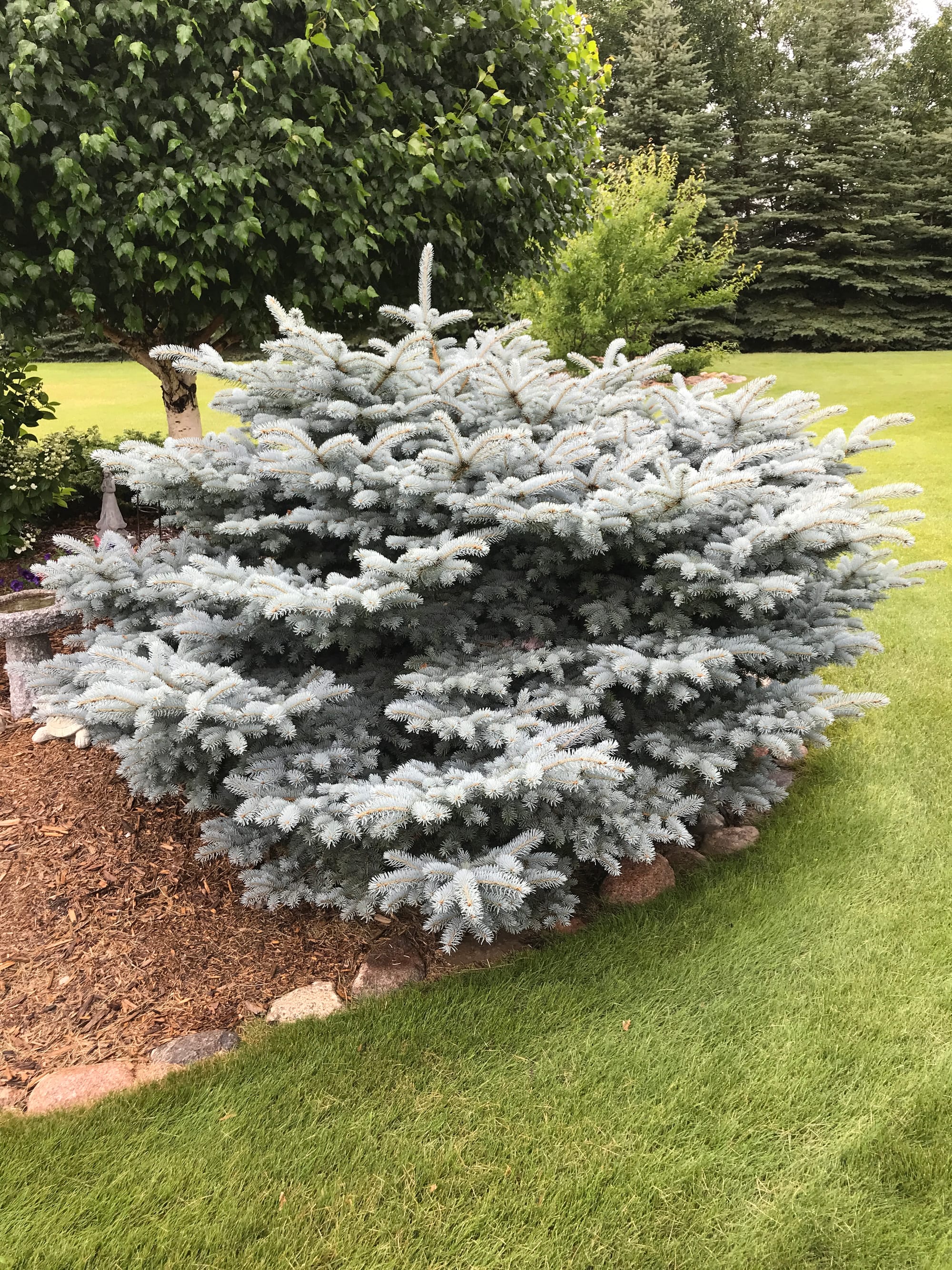
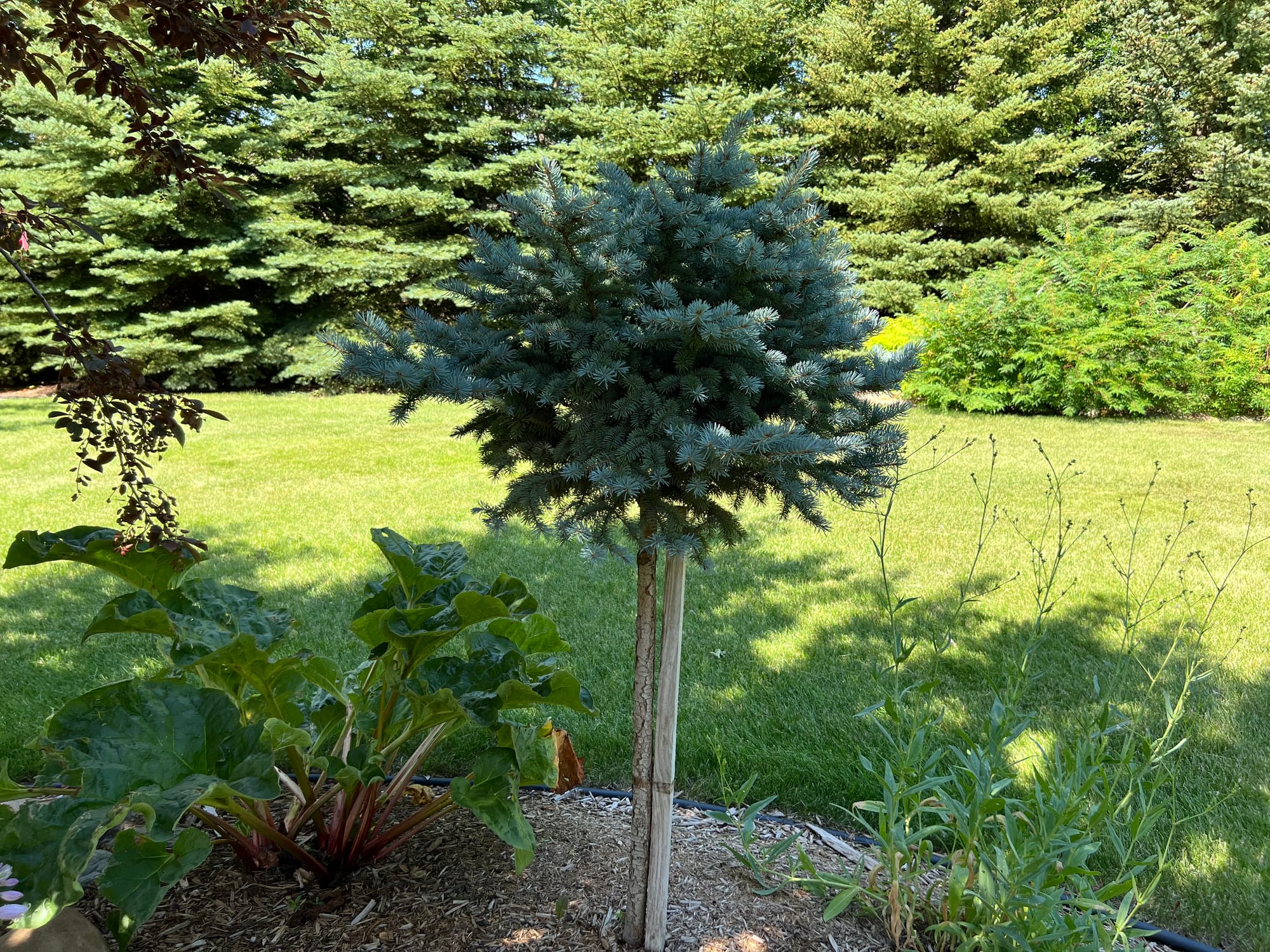
Globe Blue Spruce, Picea pungens ‘Globosa’
Sherwood Compact Bristlecone Pine, Pinus longaeva ‘Sherwood Compact’
This Pine has doubled since I planted it about ten years ago. It was a spendy little conifer ($600) for a 2-3’ plant. But I had to have it! And it is doing great in this location, growing in its perfect conical shape. Some slower-growing conifers are often very expensive since they spend so much time in the nursery production line. I’m not sure, but I’m betting the Sherwood Compact I purchased had been in production for over ten years. The oldest known living organism is a Bristle Cone Pine, over 5,000 years old. So, I guess 20 years is relatively insignificant.
- Size: 3’H x 2’W
- Hardiness: Zone 4
- Location: Full Sun
- Shape: Broad Upright
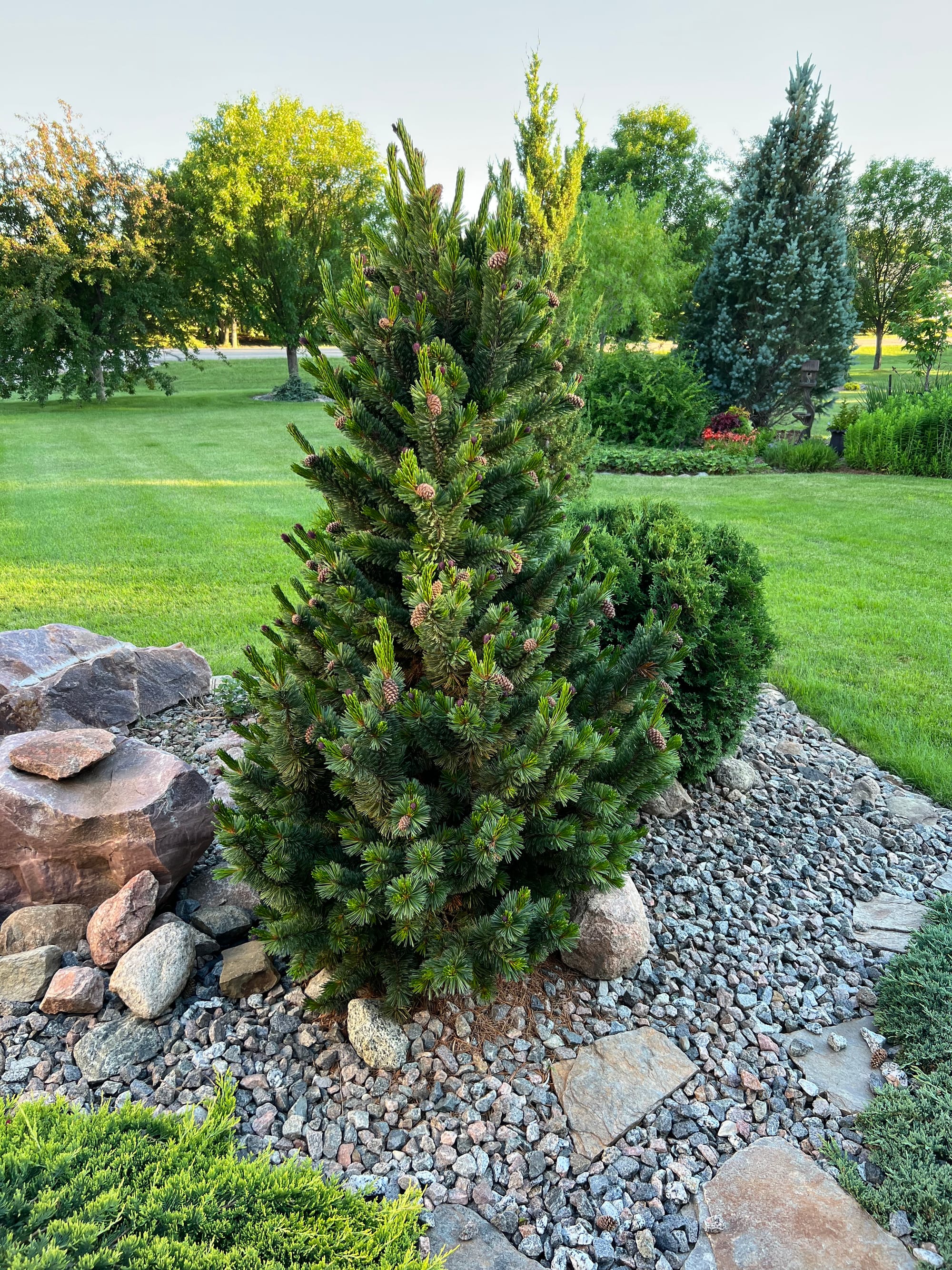
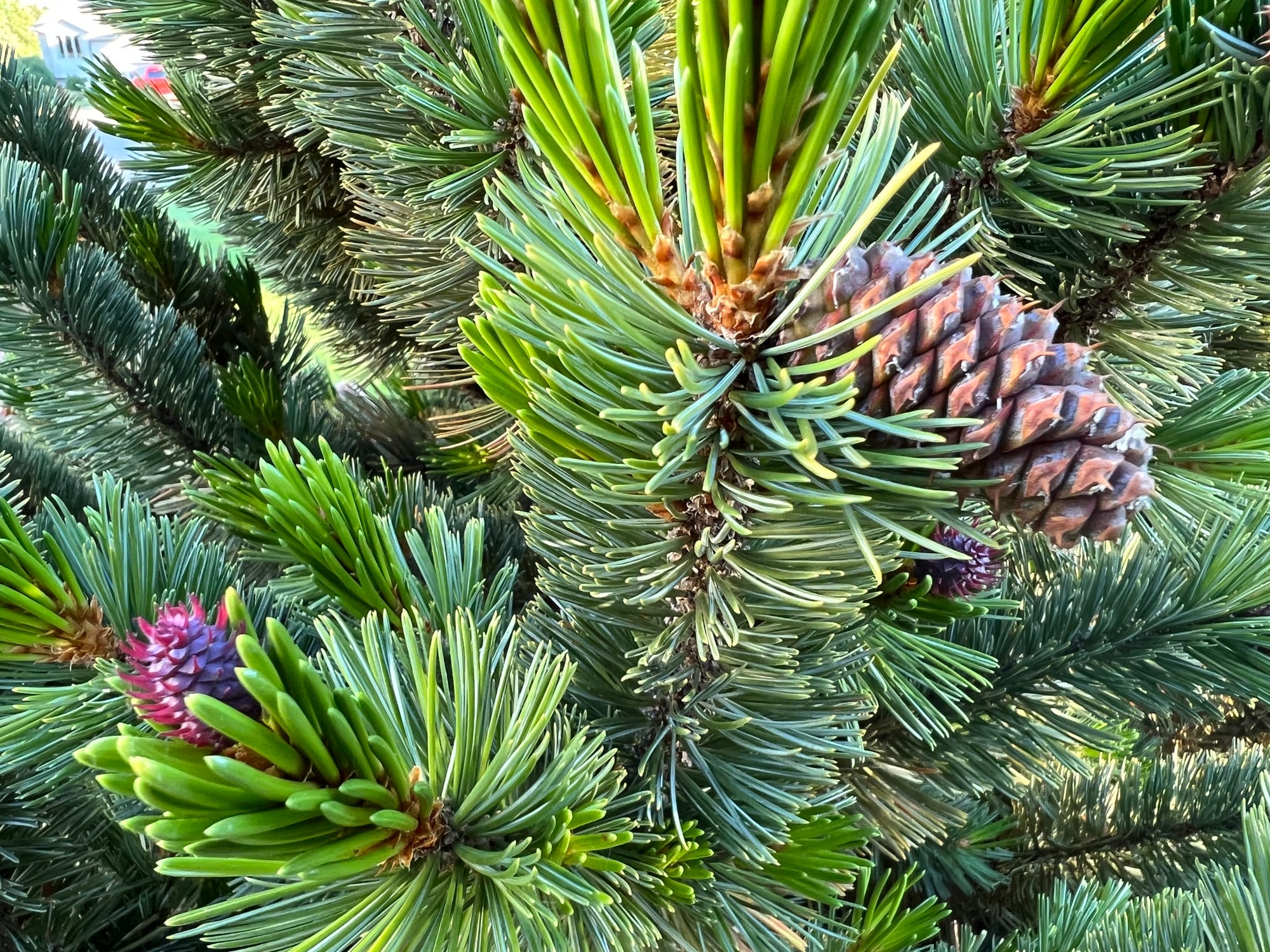
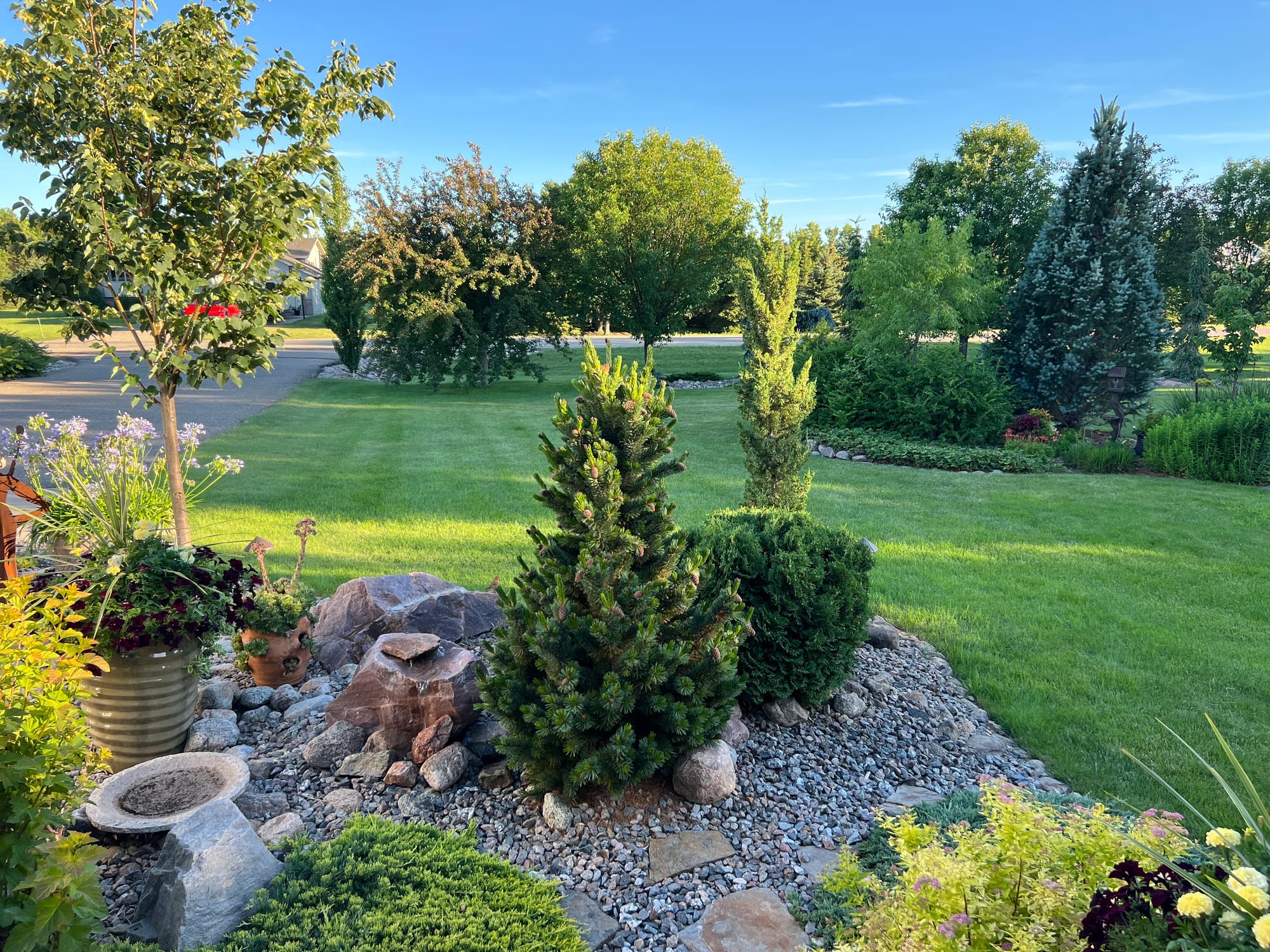
Sherwood Compact Bristlecone Pine, Pinus longaeva ‘Sherwood Compact’
Dwarf Compressed Scotch Pine, Pinus sylvestris ‘Glauca Nana’
The Scotch Pine shown here is one of my wife’s favorite plants. I’ve mentioned this Scotch Nana in a couple of other videos here and here. It is likely the most expensive plant I have ever purchased, with a retail price of $1600. (and that was about seven years ago). The first winter in the ground, it got winter burned pretty bad. Ouch. But it broke dormancy, and the new candles flushed beautifully. It can take a while for desiccated needles to fall, sometimes several months, so be patient if you have needle burn on your evergreens. I’ve kept the pruned form of this specimen with spring shearing of the elongated candles. But the growth inches ahead of you, and eventually, I will have to remove a few of the “balls” to keep that bonsai look or let it become an irregular mounding dwarf tree. It is definitely a high-maintenance tree to keep in this form, but we love it in our landscape.
- Size: 10’H x 10’W
- Hardiness: Zone 4-7
- Location: Full Sun
- Shape: Rounded

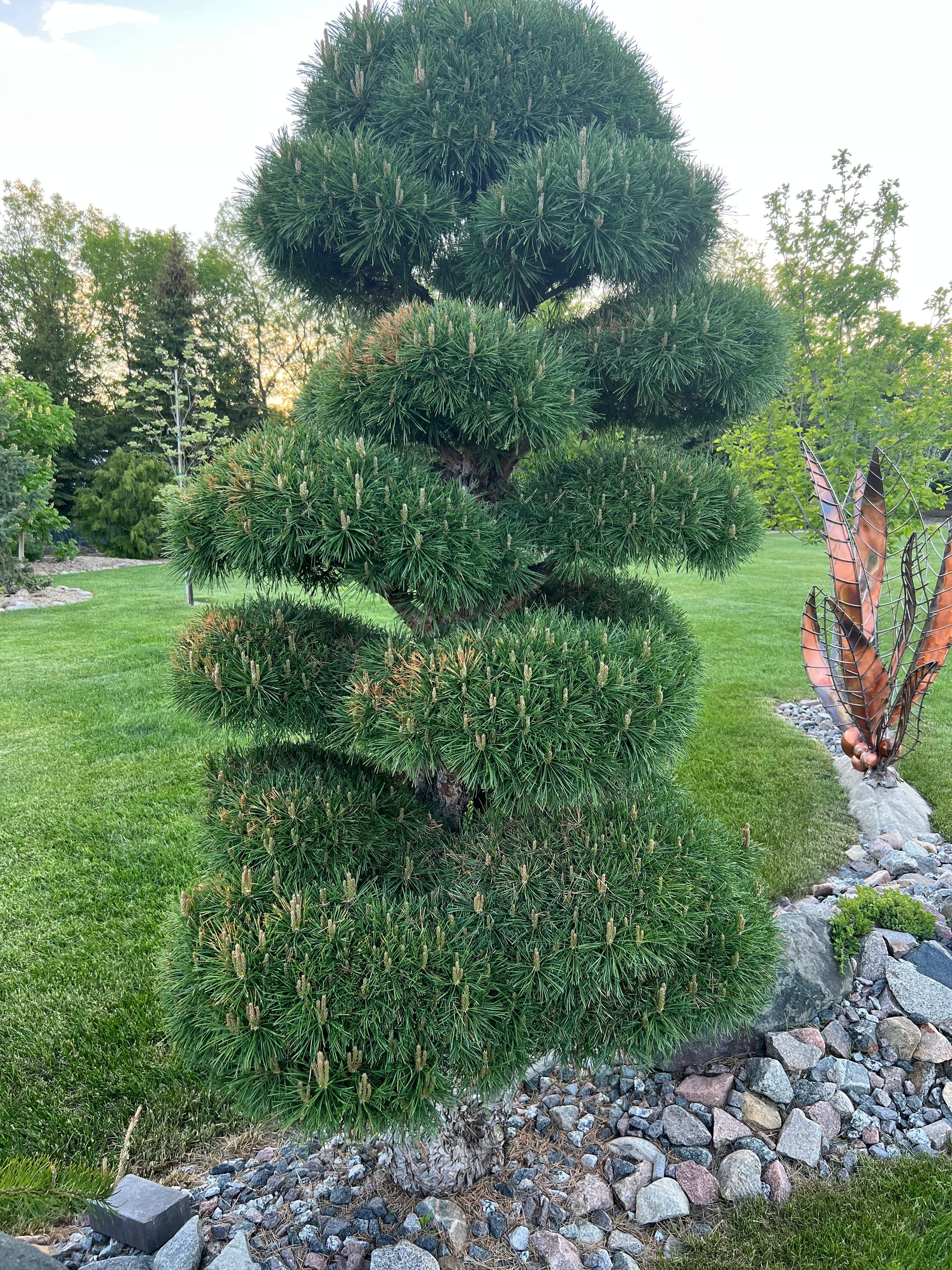
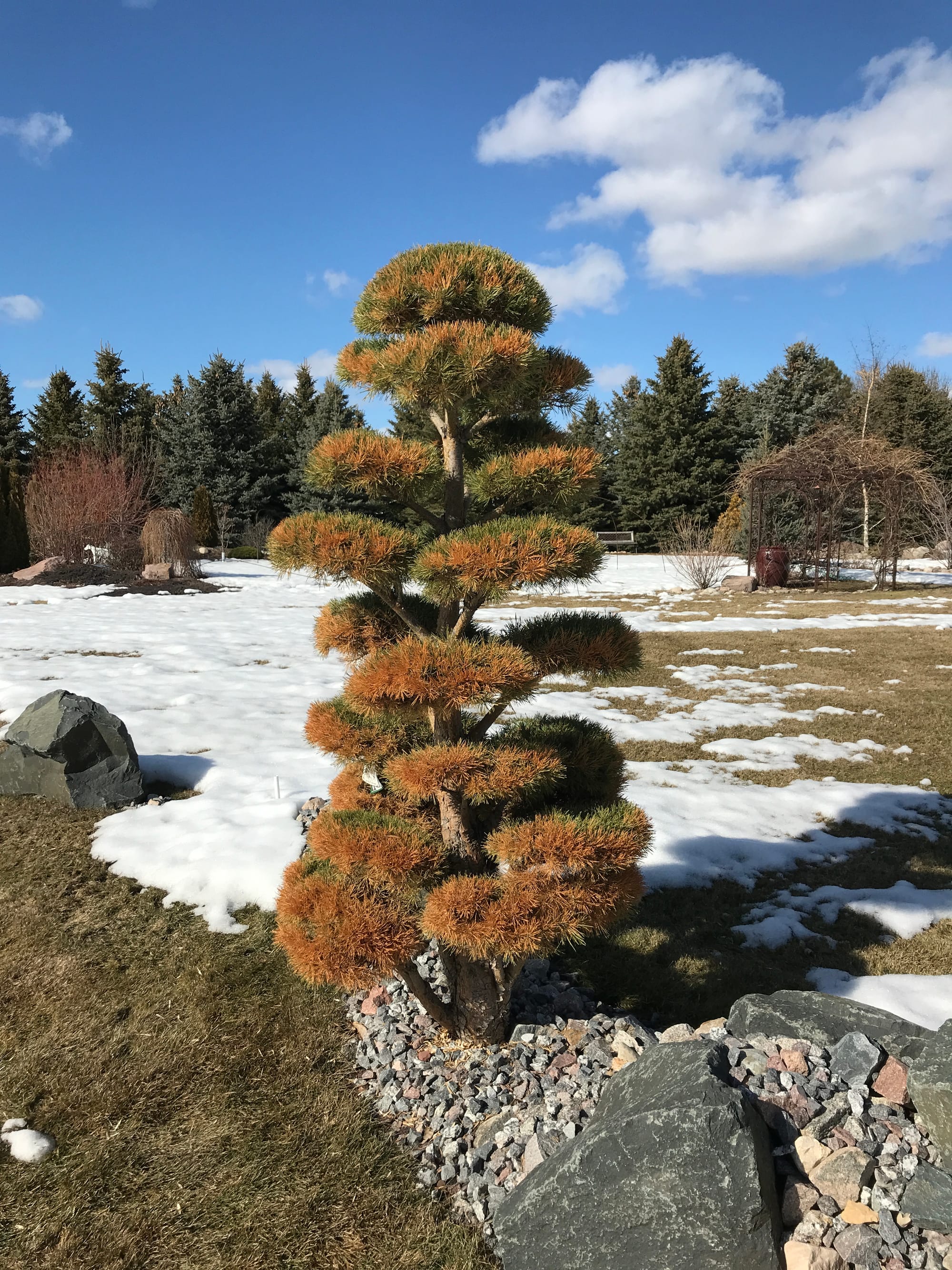
Dwarf Compressed Scotch Pine, Pinus sylvestris ‘Glauca Nana’
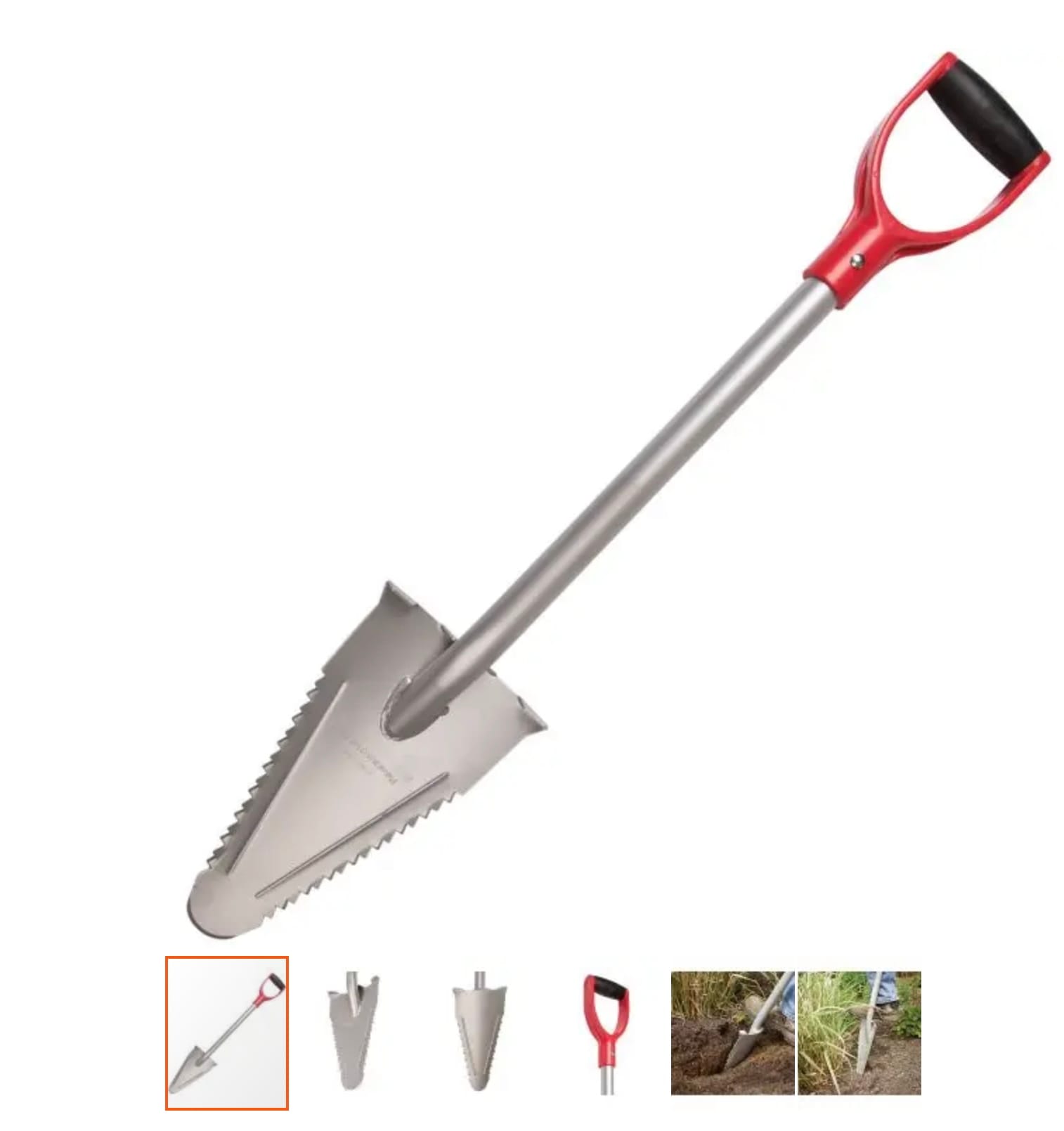
Root Assassin Steel Shovel, 32IN
Excellent for cutting through roots
When you purchase through links on this site, we may earn a small commission at no additional charge to you.
Uncle Fogy Jack Pine, Pinus banksiana ‘Uncle Fogy’
Uncle Fogy wins the prize for a favorite conifer name! Big Tuna is a close second. If you have watched the video above, I mentioned yellowing needles on our old fogy, possibly due to too much moisture. But since that video, I have determined that a scale insect is causing the yellowing problem. The scale insect will suck juices out of the plant and cause a slow decline. There are several different types of scale insects, but all have the same basic life cycle.
I did a video here discussing the Pine tortoise scale on a different jack pine that got so severe I had to remove the plant. I am not a big fan of using any insecticides, but I plan on spraying horticulture oils on it this spring as I don’t want to lose this one. Horticulture oils are organic sprays that control insects by smothering them. Scale can be challenging to control. Cross your fingers. I’ve included a photo of a larger specimen of an older Uncle Fogey I came across recently at the University of Minnesota Arboretum. Uncle Fogy's name is perfect for the unique character of this Pine.
- Size: 12’H x 8’W
- Hardiness: Zone 2
- Location: Full Sun
- Shape: Broad Upright
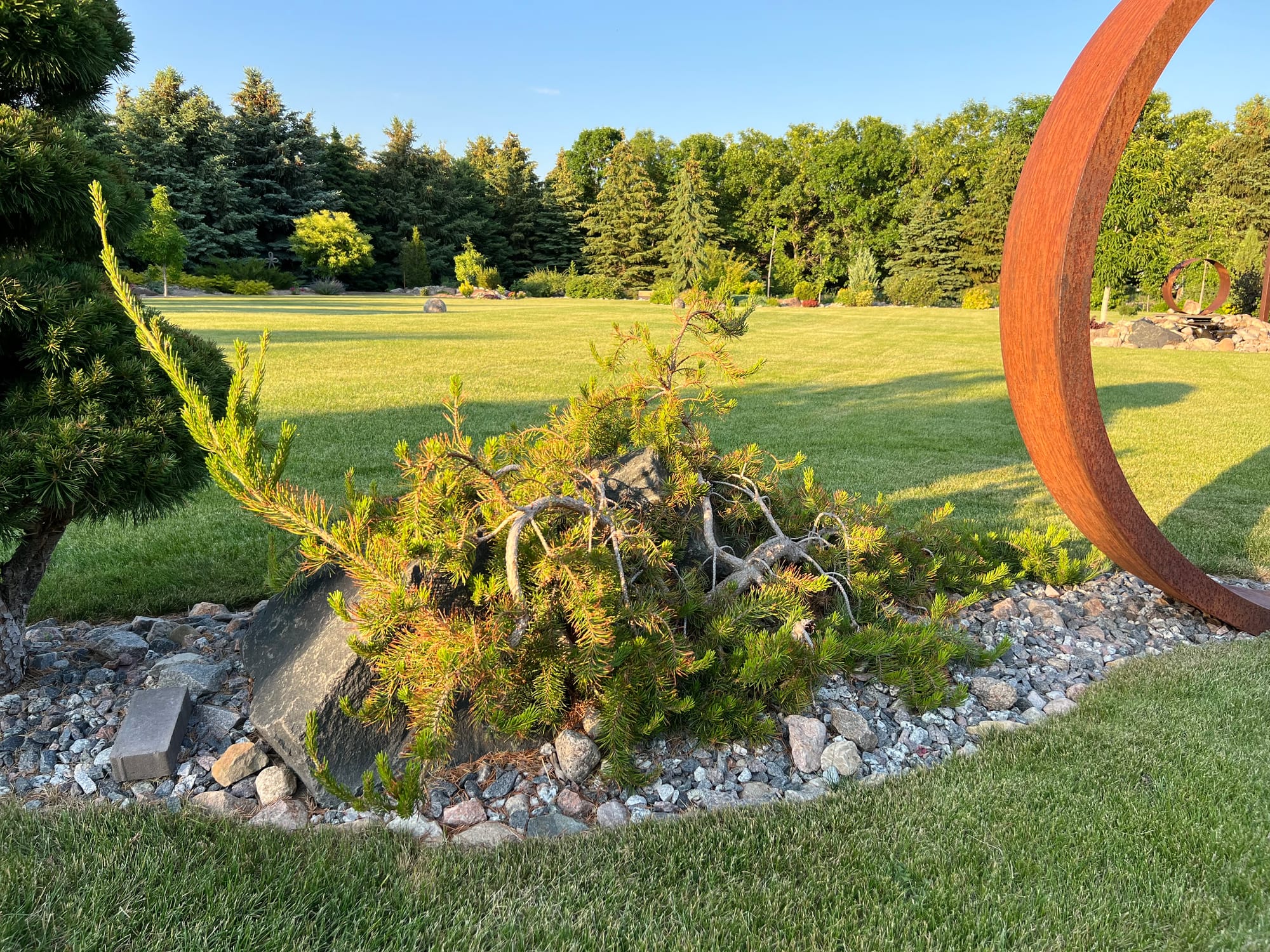
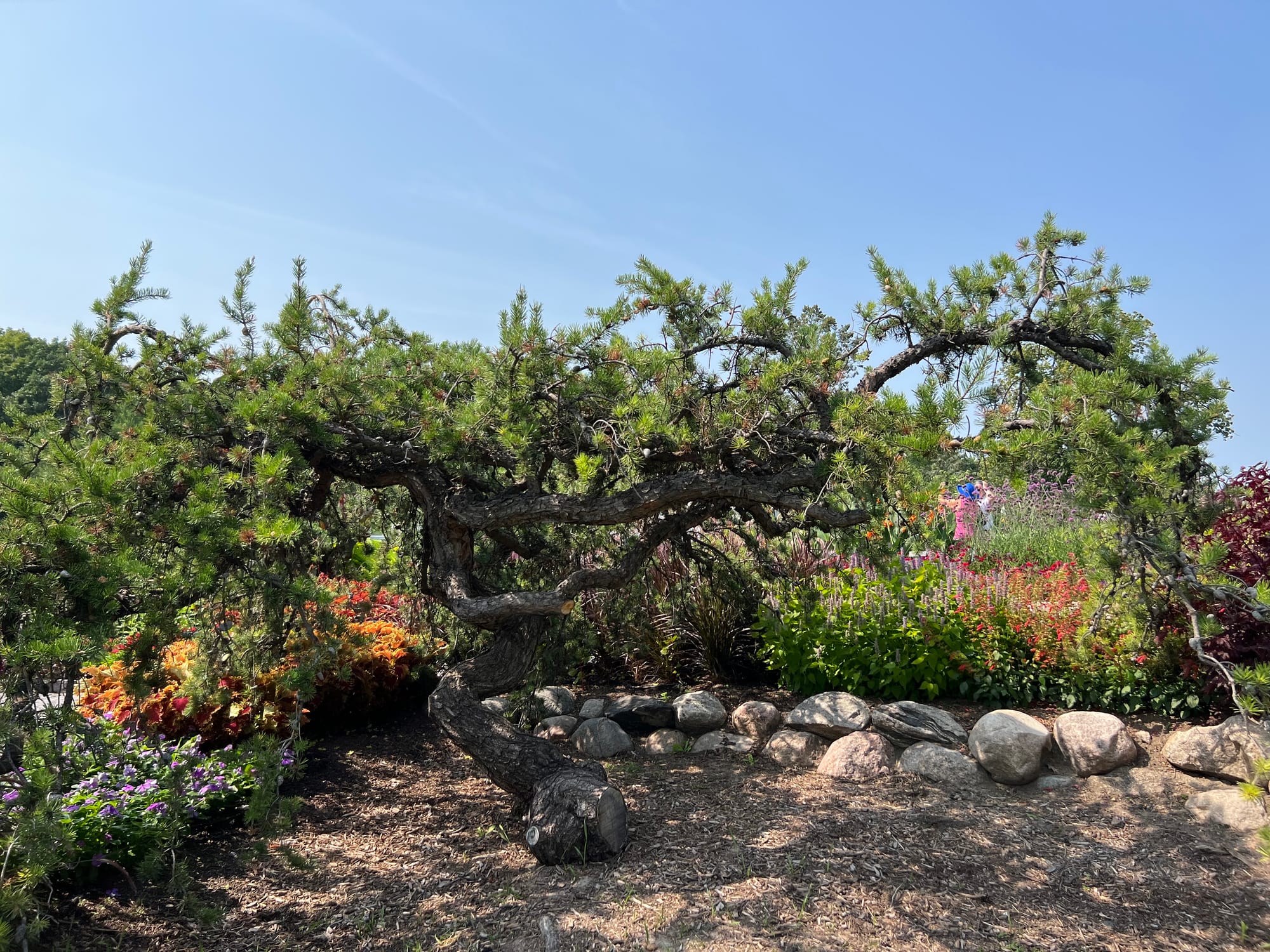
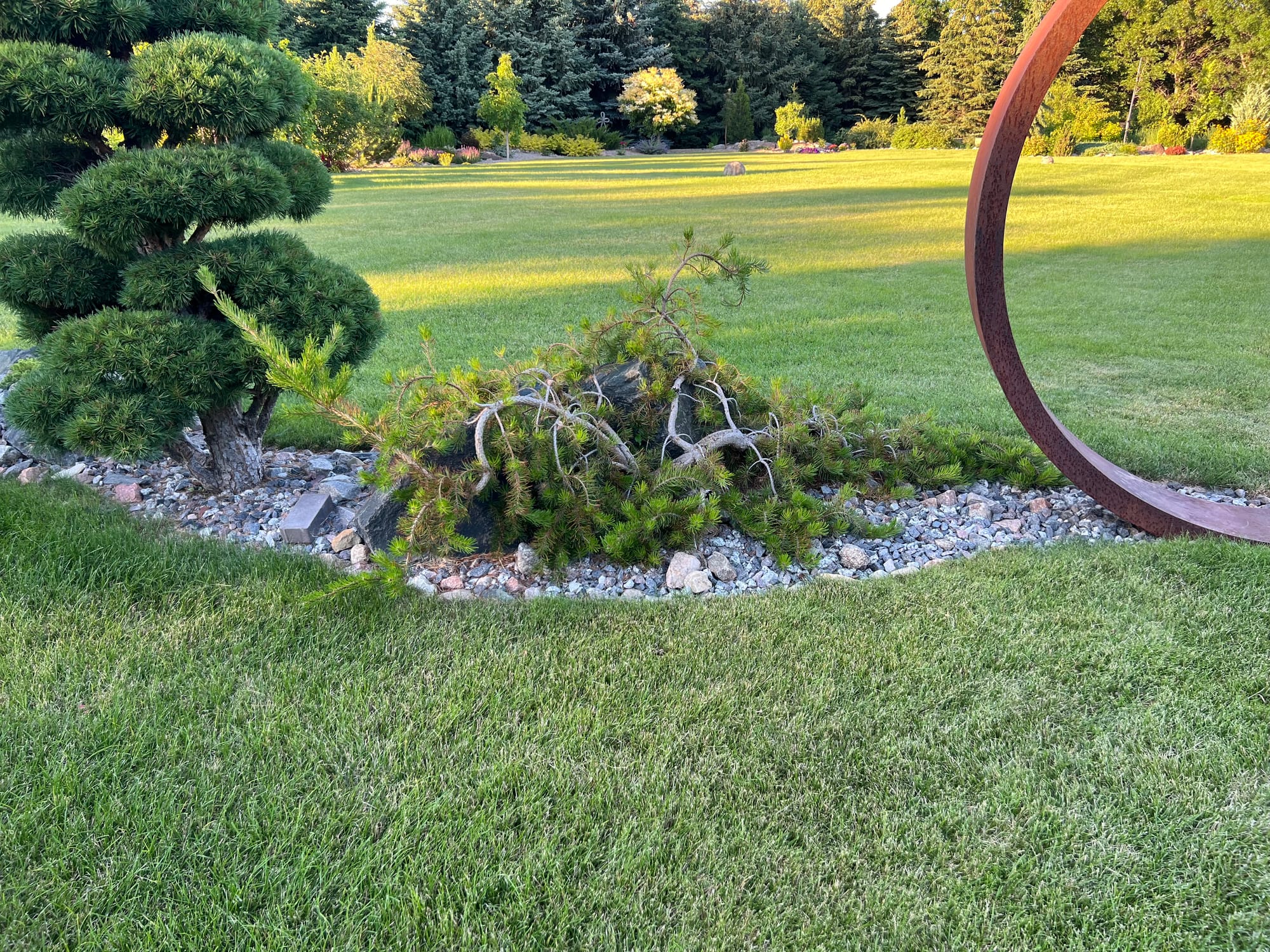
Uncle Fogy Jack Pine, Pinus banksiana ‘Uncle Fogy’
Blue Weeping Alaskan Cedar, Chamaecyparis nootkatensis ‘Glauca Pendula’
The Alaskan Weeping is not a hardy plant for my area. I have seen it listed as a Zone 4 plant in various references, but I’m betting it is a Zone 5 plant. I have used this tree as an accent in an upright metal container in one of my favorite landscape beds for many years. You can watch a video on that bed here. Since the tree is still in its original container, it is now starting to show stress during the growing season due to a more and more root-bound condition. I will plant it into the ground now, and we’ll find out soon enough if it is hardy.
This Weeping Blue Cedar is not a true Cedar but a false cypress. I’ve included a photo below of another false cypress that I grow in a container. It is still thriving after five years in the same pot.
- Size: 30’H x 15’W
- Hardiness: Zone 5 (maybe 4)
- Exposure: Full sun to part shade
- Shape: Upright Weeping
Winter Sun Mugo Pine, Pinus mugo ‘Wintersonne’
I could say, “This is a favorite” of nearly every plant I discuss. But this is truly a favorite, so it must be in the top 10. I was hoping it would stay a little smaller in the location where I planted it. I don’t want it to block a cool Larch I have behind it: Horstman’s Recurved (next on the list).
But I will have to start giving it a spring shearing now, as it has reached the maximum size I would like. In contrast to the Taylor’s Sunburst discussed above, the Winter Sun has fall/winter yellow needles rather than yellow spring growth. It’s genuinely like the winter sun.
- Size: 6’H x 4’W
- Hardiness: Zone 2
- Location: Full Sun
- Shape: Broad Upright
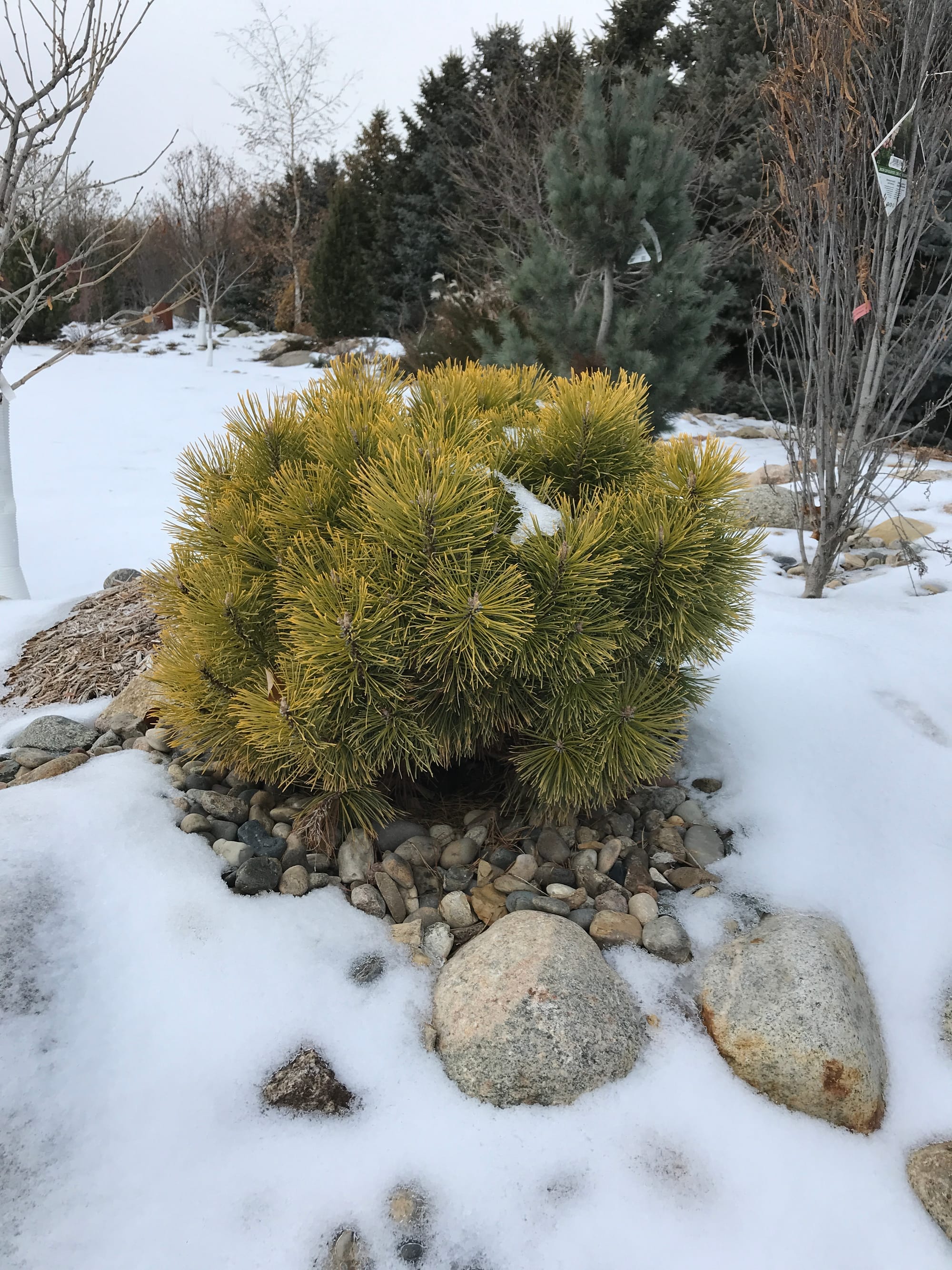
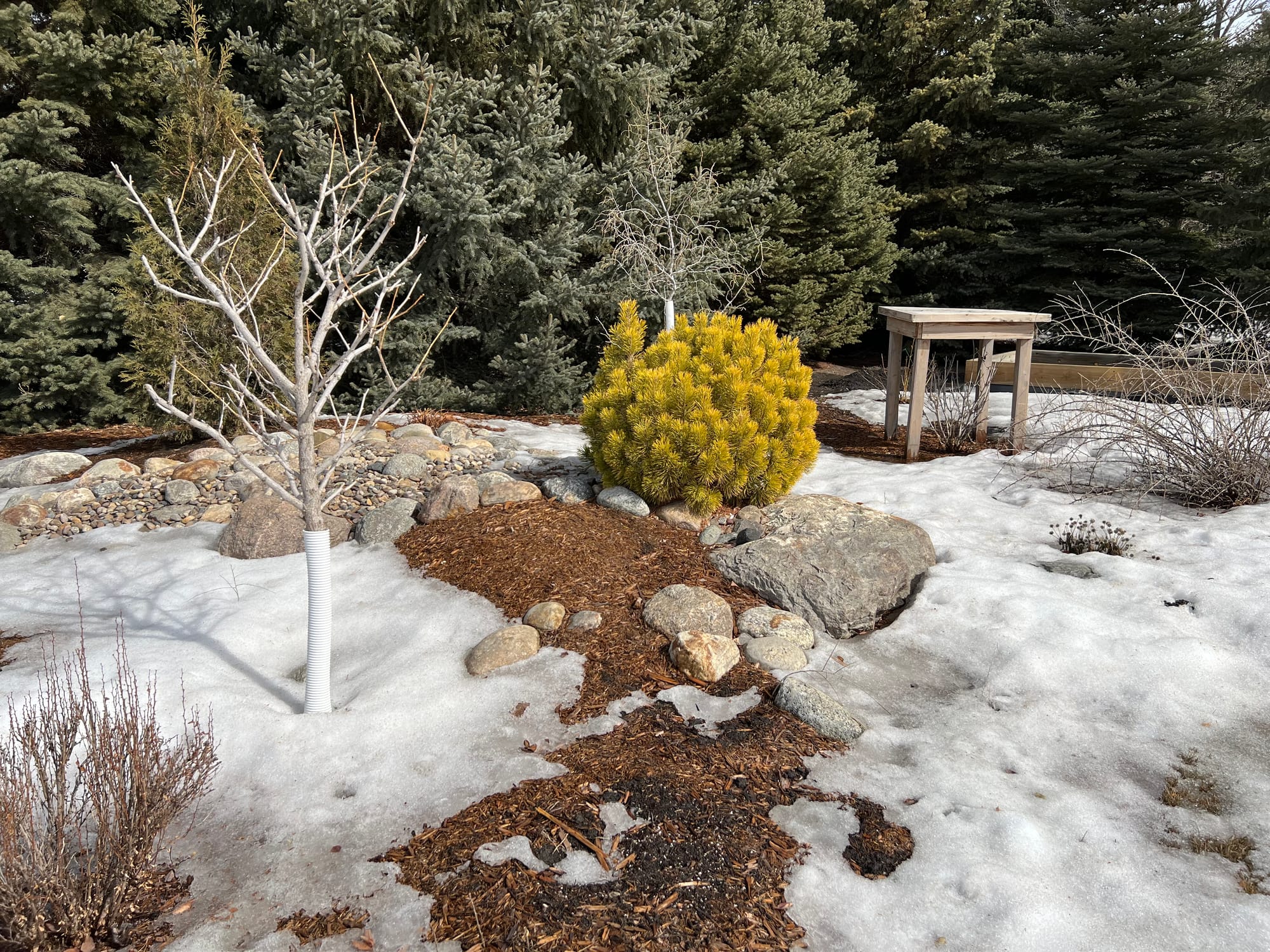
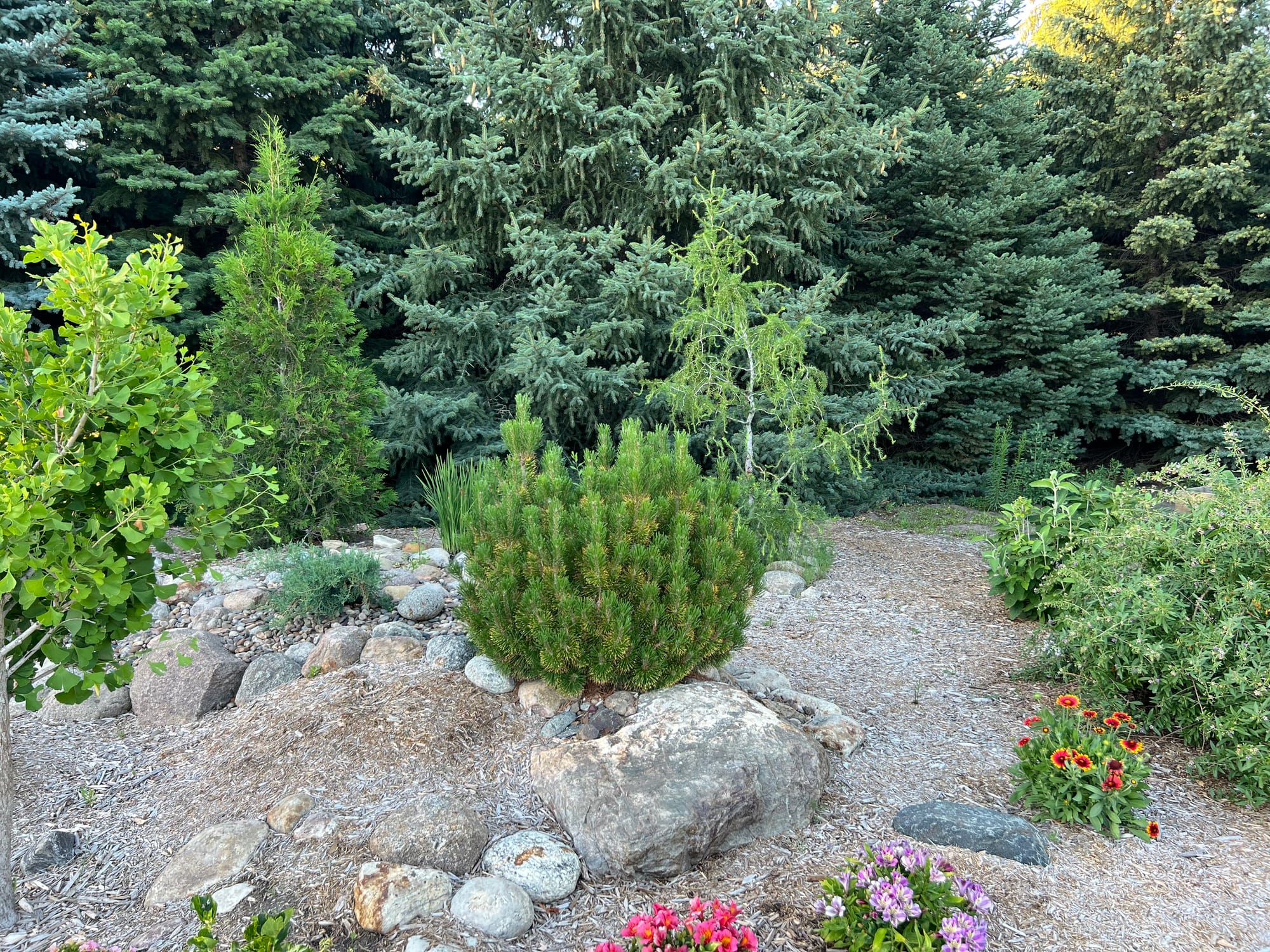
Winter Sun Mugo Pine, Pinus mugo ‘Wintersonne’
Horstman’s Recurved Larch, Larix decidua ‘Horstmann’s Recurva’
If you need to make a statement, you need a Horstman’s. I have two planted in our landscape. The Larch is native to wet, lowland areas but will tolerate dry conditions. I can attest to that, as I have one in an incredibly dry area and one in a moist area. Both are doing great. A few years ago, I had a close call on the one in the dry area where deer rubbed on the trunk, causing significant bark damage. But it has healed up well. The statement from this Larch comes from the wispy branches that curl and twist. The effect is especially noticeable in the winter. Larch needles are soft to the touch, have a yellow fall color, and drop in the winter.
- Size: 12’H x 8’W
- Hardiness: Zone 2
- Location: Full Sun
- Shape: Upright
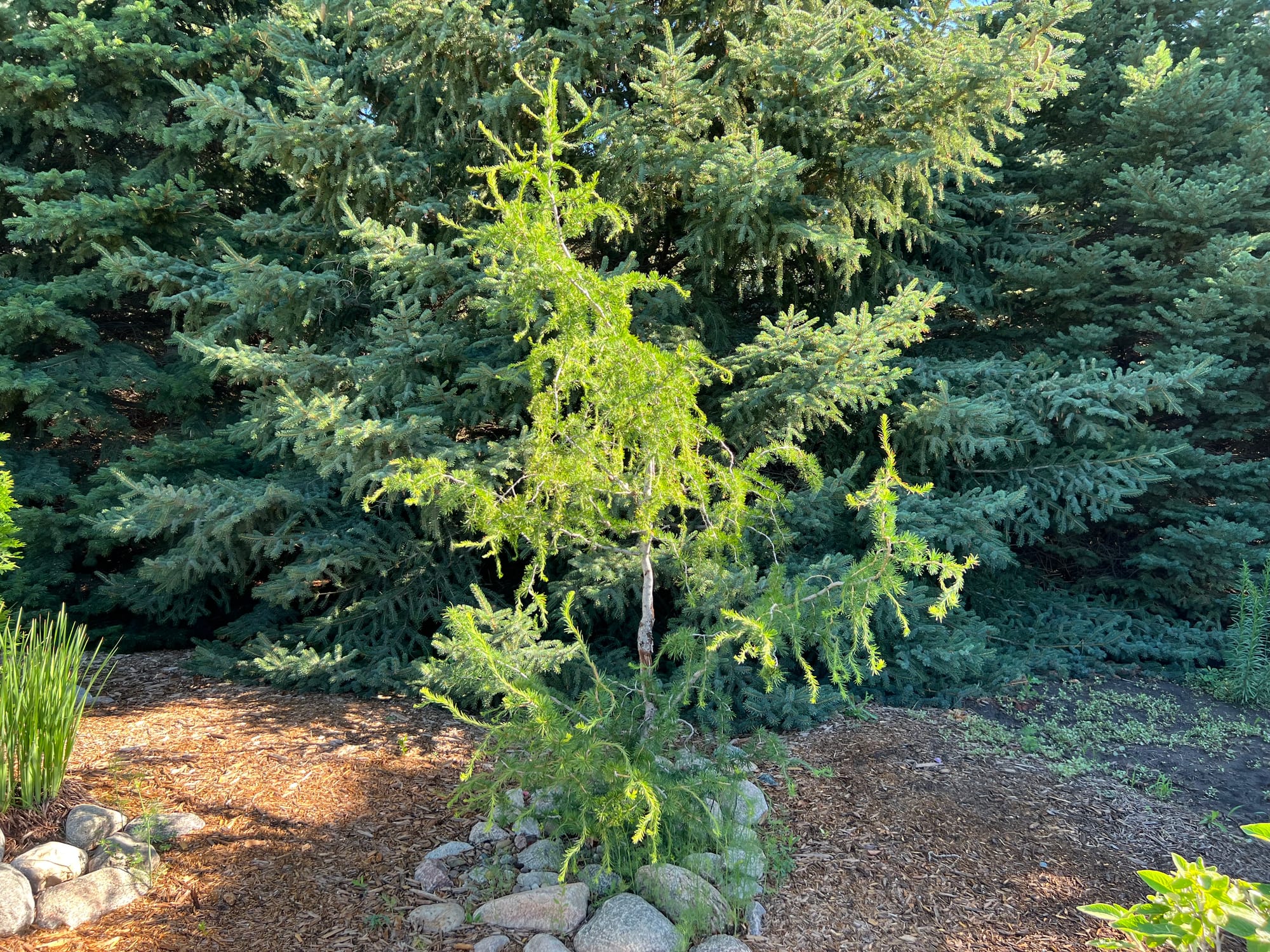
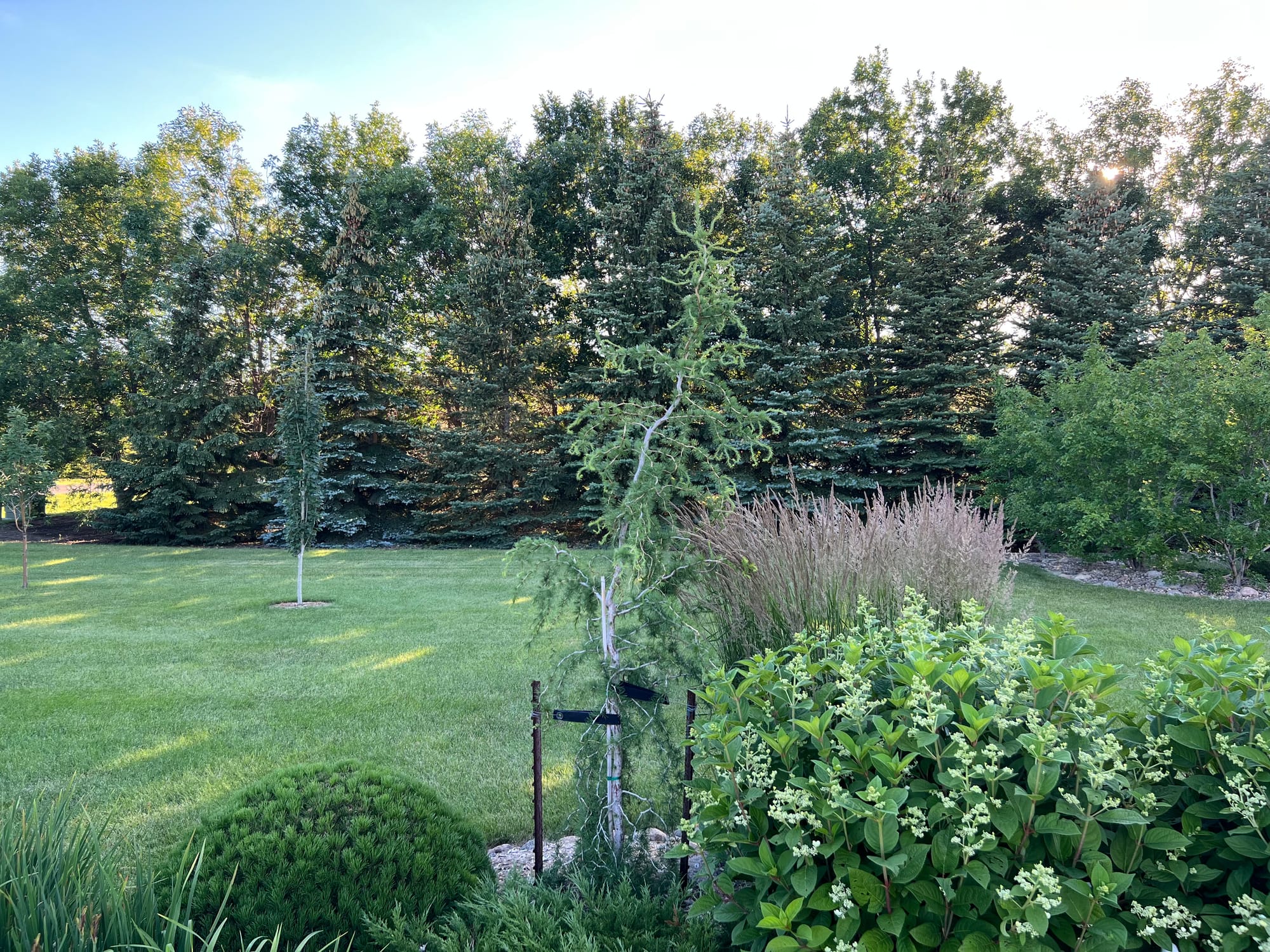
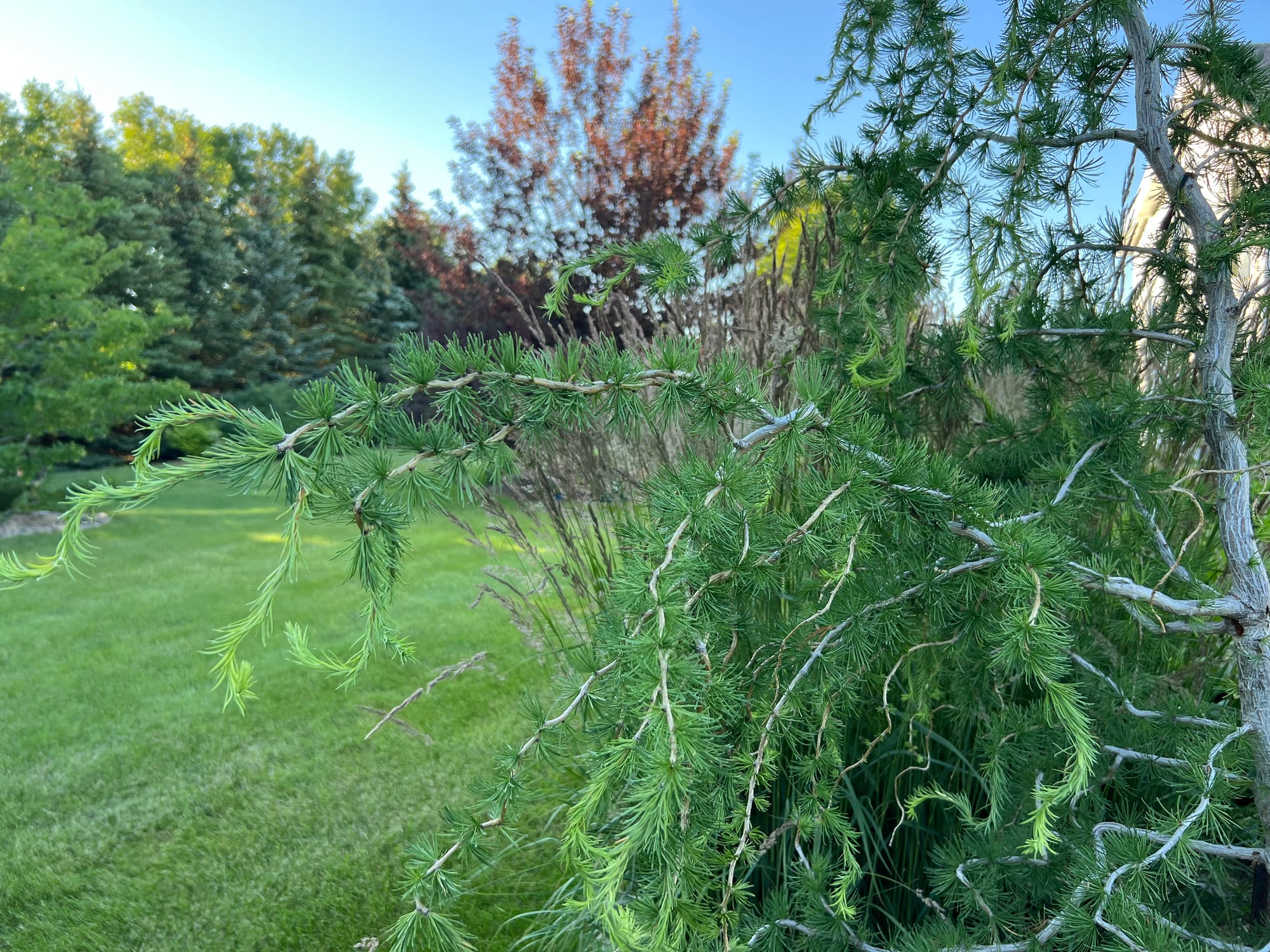
Horstman’s Recurved Larch, Larix decidua ‘Horstmann’s Recurva’
Weeping White Spruce, Picea glauca ‘Pendula’
The Weeping White is another favorite! I had three growing in our landscape up until this fall. One would flush out new growth in the spring and “brown up” as the season progressed. I finally decided to remove it after several years of limping along. I love the slightly crooked upright trunk with dominant pendulous branches on this variety. Weeping White has bluish-green needles and is very hardy, down to zone 2.
- Size: 15-20’H x 4’W
- Hardiness: Zone 2
- Location: Full Sun to Part Shade
- Shape: Narrow Upright
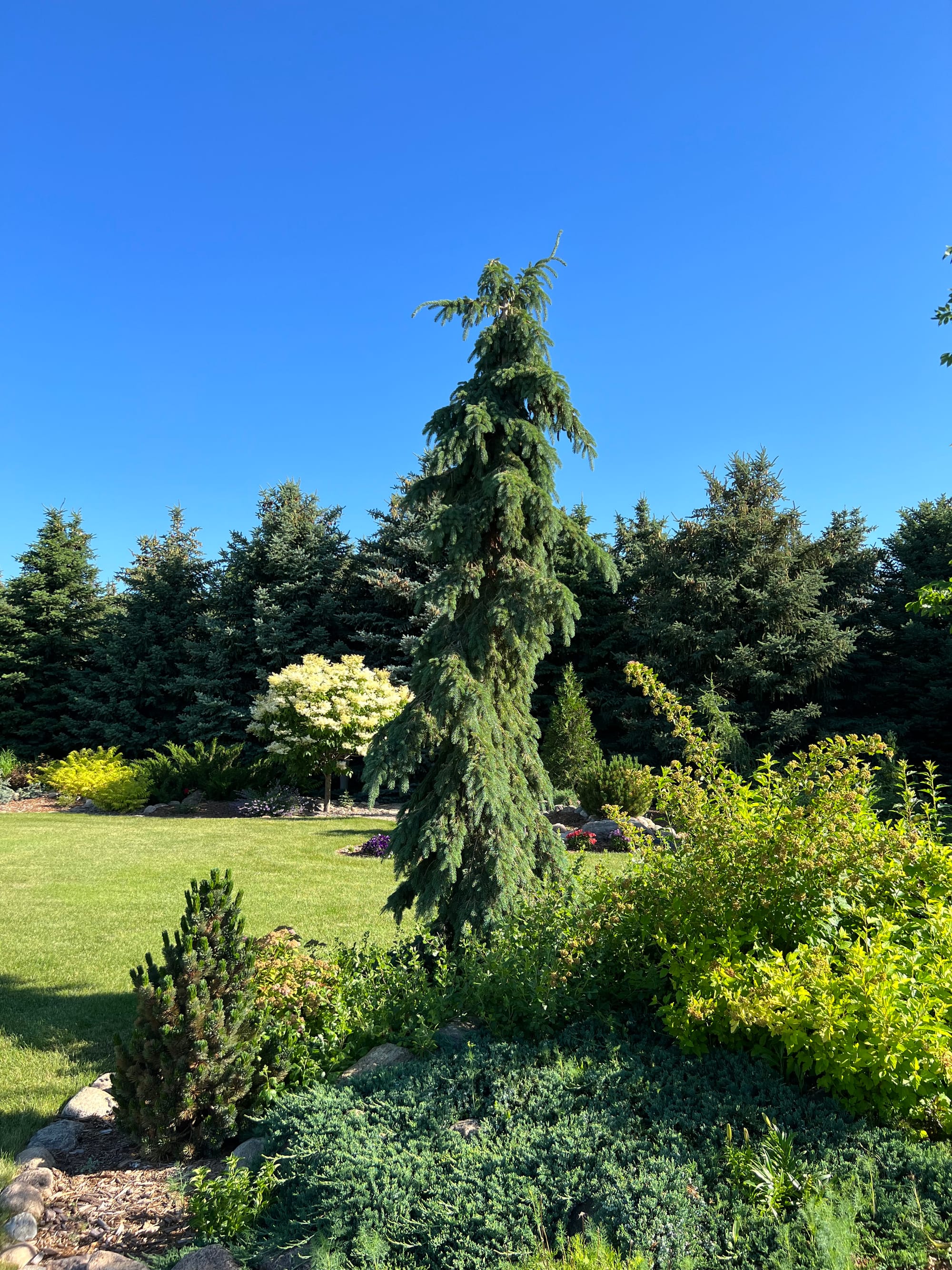
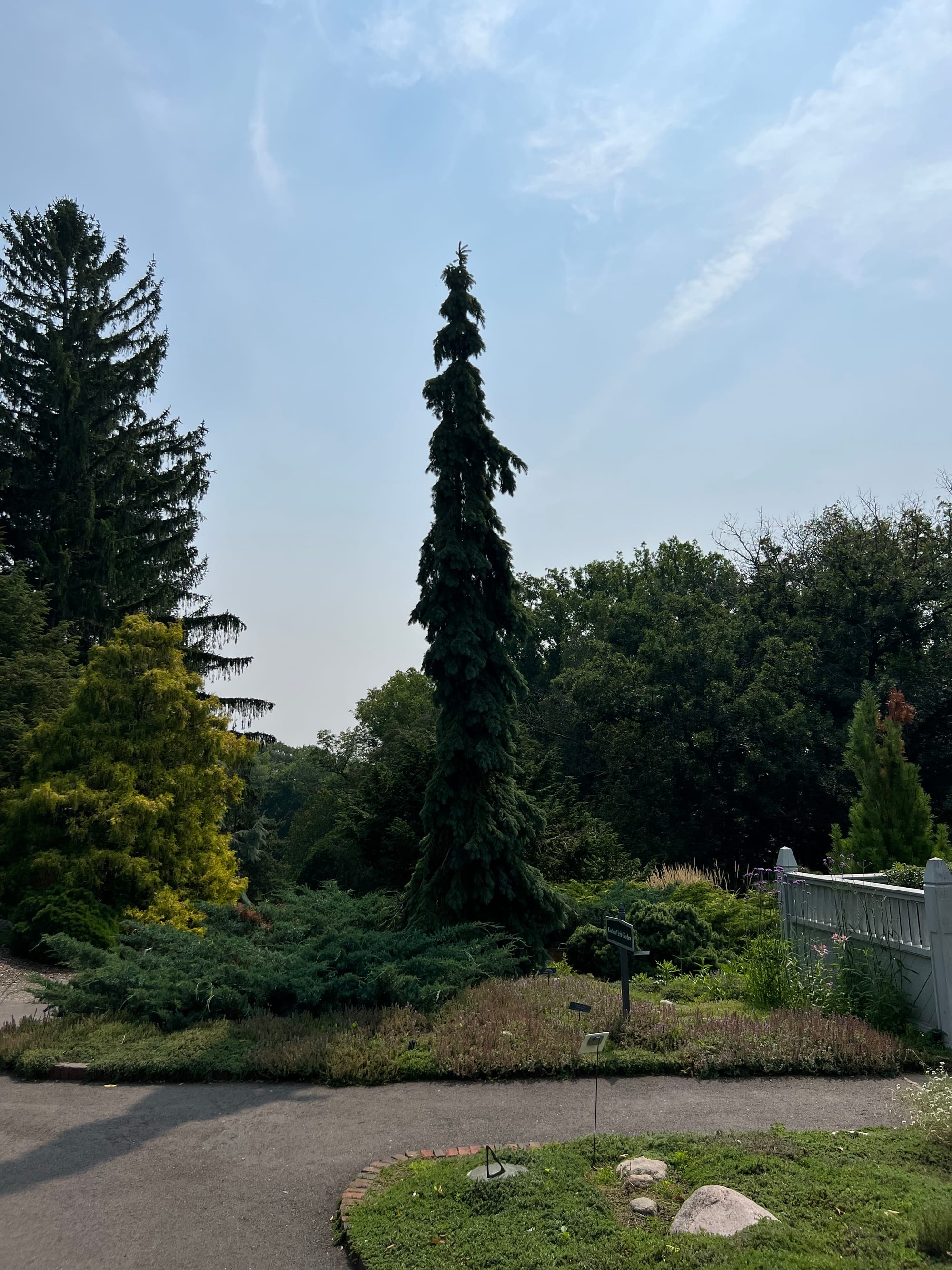
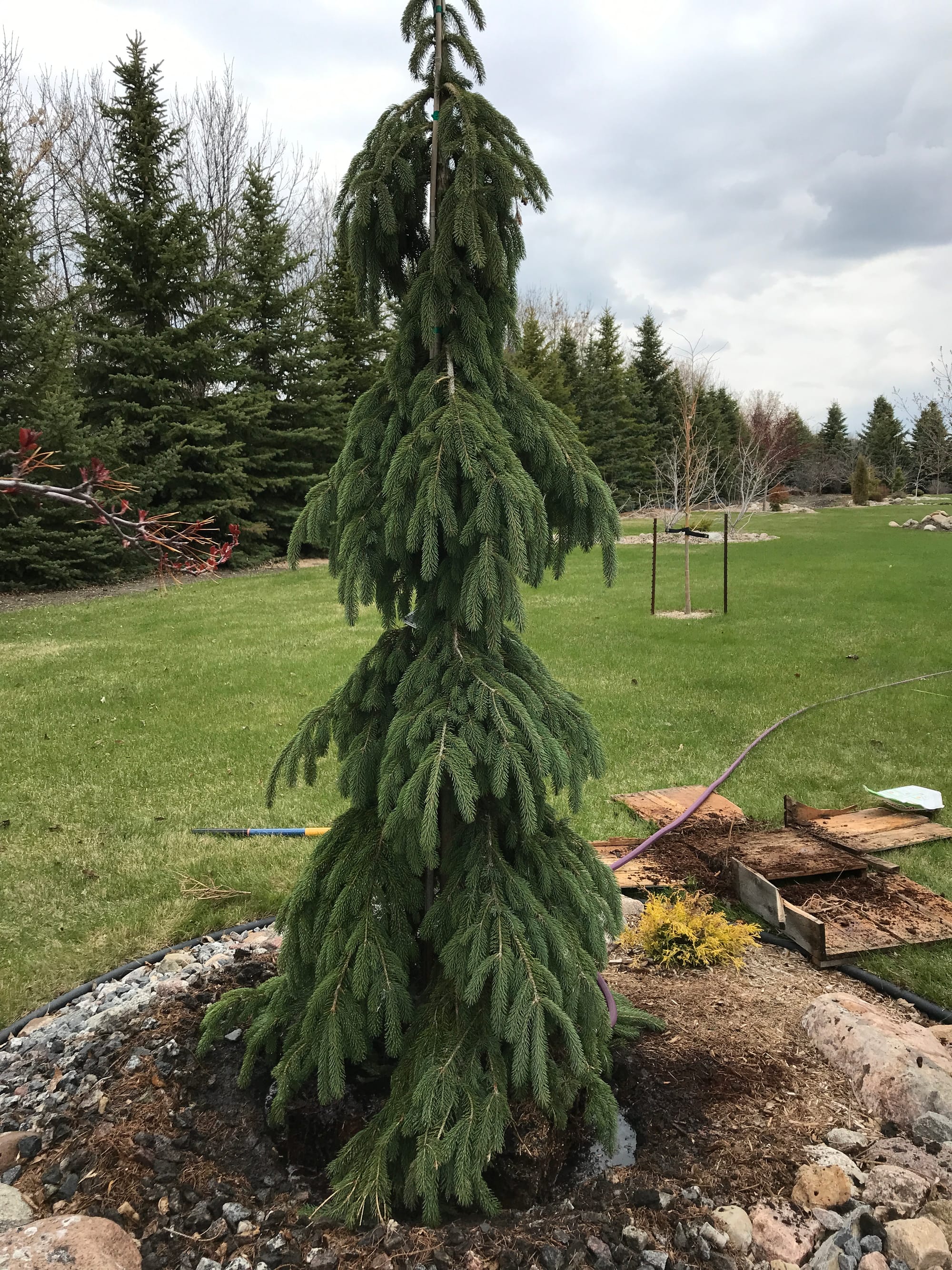
Weeping White Spruce, Picea glauca ‘Pendula’
Video on summer to winter comparison of all these great conifers:
Thanks for stopping by Garden Hike!
Kevin
Garden Hike is supported by its audience. When you purchase through links on this site, we may earn a small commission at no additional charge to you. Thank you.
Enter Discount Code GARDENHIKE10 at checkout to receive 10% off any order
Click A.M.Leonard’s banner below to check out their great selection of tools and supplies.

